






For those of you lucky enough to have benefited from a lifetime in this great game, you understand the joy, discipline, and community that golf brings.We have an opportunity to pass that gift along to the next generation—while providing ourselves a little fun in the process.
While not every golfer plays to compete, every golfer loves to win. While we can’t guarantee it on the links, we can guarantee that beginning next month we will have two raffle winners each month for a year and you could be one of them.
First Drawing: September 20-21, 2025, at the Montana State Four-Ball Championships, played at Buffalo Hill Golf Course in Kalispell.
Buy Your Ticket Now: msga.org/raffle-fundraiser
24 CHANCES TO WIN – GREAT ODDS, GREAT CAUSE
• Only 300 tickets sold each year
• 12 amazing trips to incredible destinations across the continent
• 12 cash prizes of $200 each
Every ticket supports the MSGA Junior

Grant Program, helping kids in grades K–8 across Montana discover the game we love.
A decade ago, dedicated board members from both the Montana State Women’s Golf Association and the Montana State Golf Association (before the 2018 merger) set out to create a sustainable way to fund junior golf.
The result? The Trip-of-the-Month Raffle—a creative way to support local programs while giving golfers something exciting to look forward to all year.
Since the first drawing, 10 grant cycles have funded equipment, coaching, clinics, and course access for young golfers statewide. Some kids who picked up a club for the first time through the program are now competing in high school tournaments—others simply

found a lifelong love for the game.
• Clubs and schools apply annually for Junior Player Development Grants.
• Funding supports everything from starter clubs to instructional clinics and course access.
Golf teaches patience, sportsmanship, and resilience. Your raffle ticket helps a child take their first swing, make their first par, and

maybe, one day, represent Montana in competition—no matter their location or family resources.
1. Buy Your Ticket Now: https://www. msgagolf.org/raffle-fundraiser/
2. Share the raffle with friends, club members, and playing partners.
3. Want to give more? Make a direct donation here.
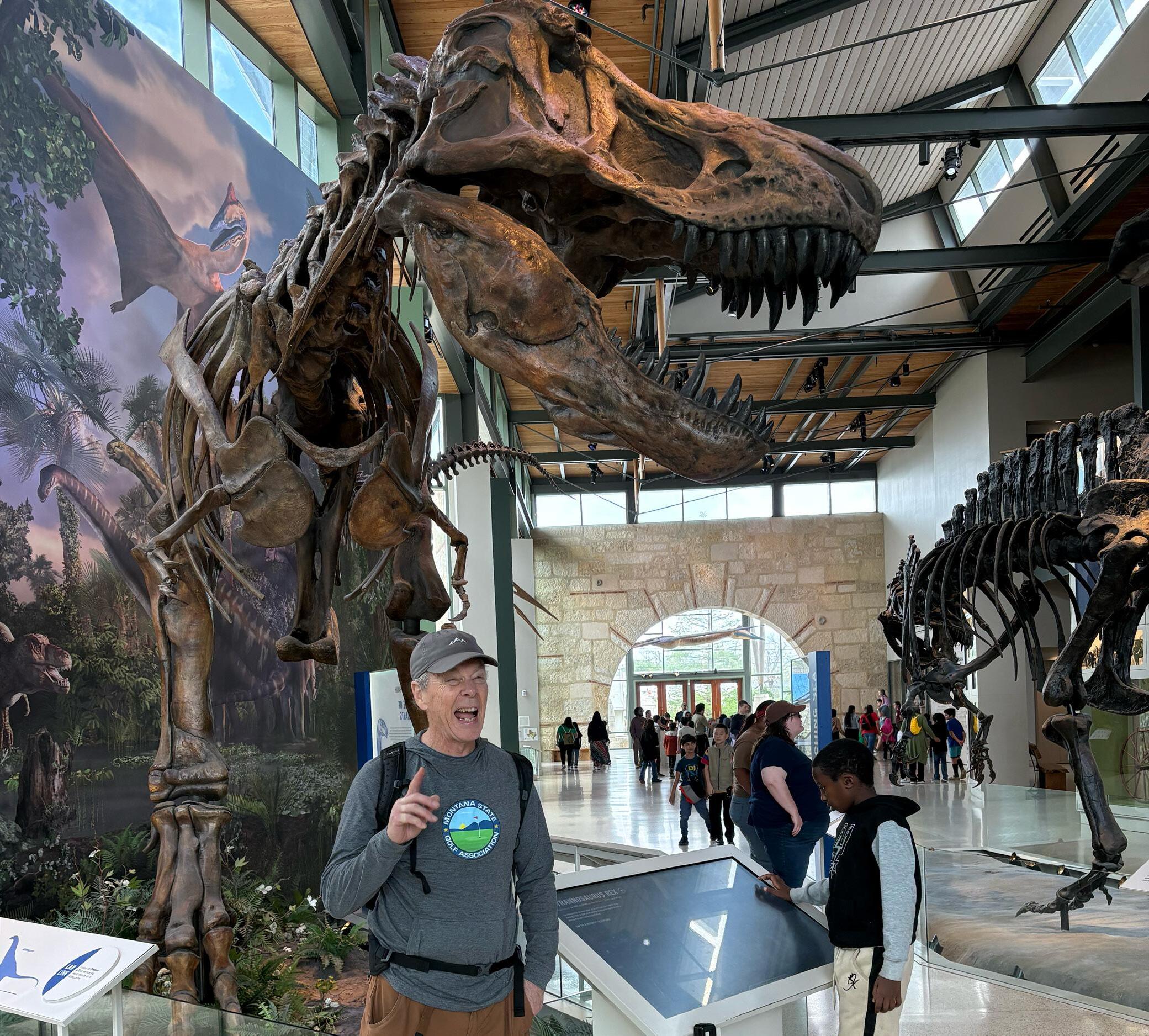
The first drawing for the 2025-26 raffle year will be held during the Montana State FourBall Championships, held September 2021—so don’t wait!
Your ticket could win an unforgettable trip—or $200 in cash.
It will definitely help grow the game for Montana’s youth.
I’ve got my ticket. Will you join me?
Don’t Delay, Purchase Today: https://www.msgagolf.org/raffle-fundraiser/


BOARD OF DIRECTORS - OFFICERS
PRESIDENT................................................... Peter Benson
VICE PRESIDENT.................................. Ron Ramsbacher
TREASURER....................................................... Bill Dunn
PAST PRESIDENT......................................... Mary Bryson
EXEC COMMITTEE......................................... Karen Rice
BOARD OF DIRECTORS
Brett Bennyhoff, Peter Benson, Carla Berg, Mary Bryson, Bill Dunn, Cheri Ellis, Lisa Forsberg, Marcia Hafner, Ron Ramsbacher, Karen Rice, Joe Rossman, Rod Stirling
MSGA STAFF
Executive Director......................................... Nick Dietzen
Tournament Director...................................... Tim Bakker
Membership Operations Director............... Emily Hulsey
Member Services Coordinator......................... Ian Hulsey
Communications & Tournament Manager.... Katie Fagg
Communcations Coordinator.......................... Ty Sparing
Partnerships & Business Development...... Nick Dietzen
USGA PJ Boatwright, Jr. Intern................ Dean Hendrix
USGA PJ Boatwright, Jr. Intern...................... Ella Prigge
USGA PJ Boatwright, Jr. Intern................ Stella Claridge
PARTNERSHIPS
Nick Dietzen.... ......................... 1 (800) 628-3752, ext. 6
406GOLF STAFF
Editor in Chief............................................... Nick Dietzen
Consulting Editor........................................ David Bataller
Senior Writer..................................................... Ty Sparing
Graphic Designer............................................... Katie Fagg
Contributing Writer..................................... Emily Hulsey
Contributing Writer.................................... Stella Claridge
Contributing Writer.......................................... Nina Sims
Contributing Writer................................... David Schefter
Contributing Writer....................................... Jim Corbett
Contributing Writer..................................... Ross Niewola

Montana State Golf Association P.O. Box 4306
Helena, MT 59604
1 (800) 628-3752
www.msgagolf.org
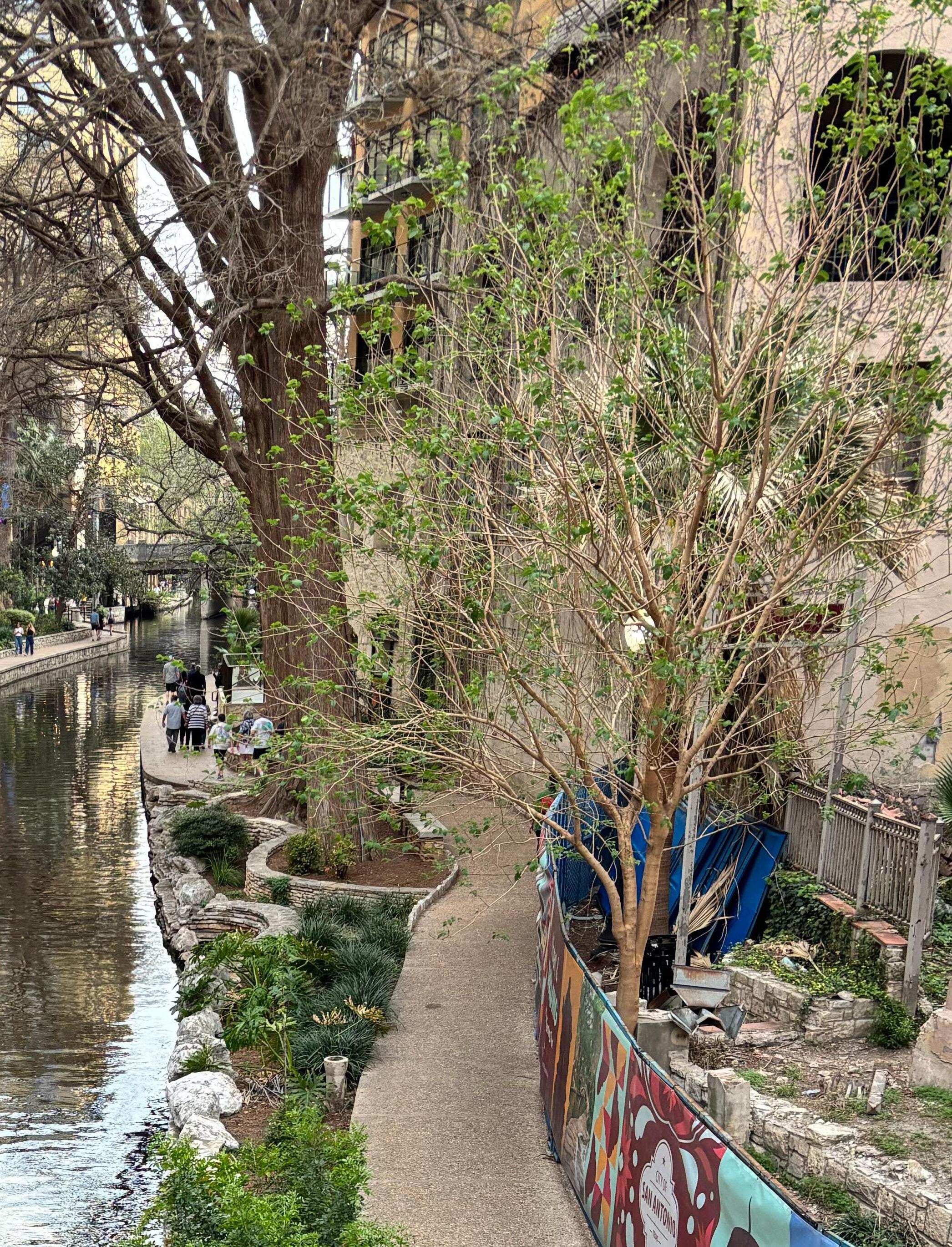
-

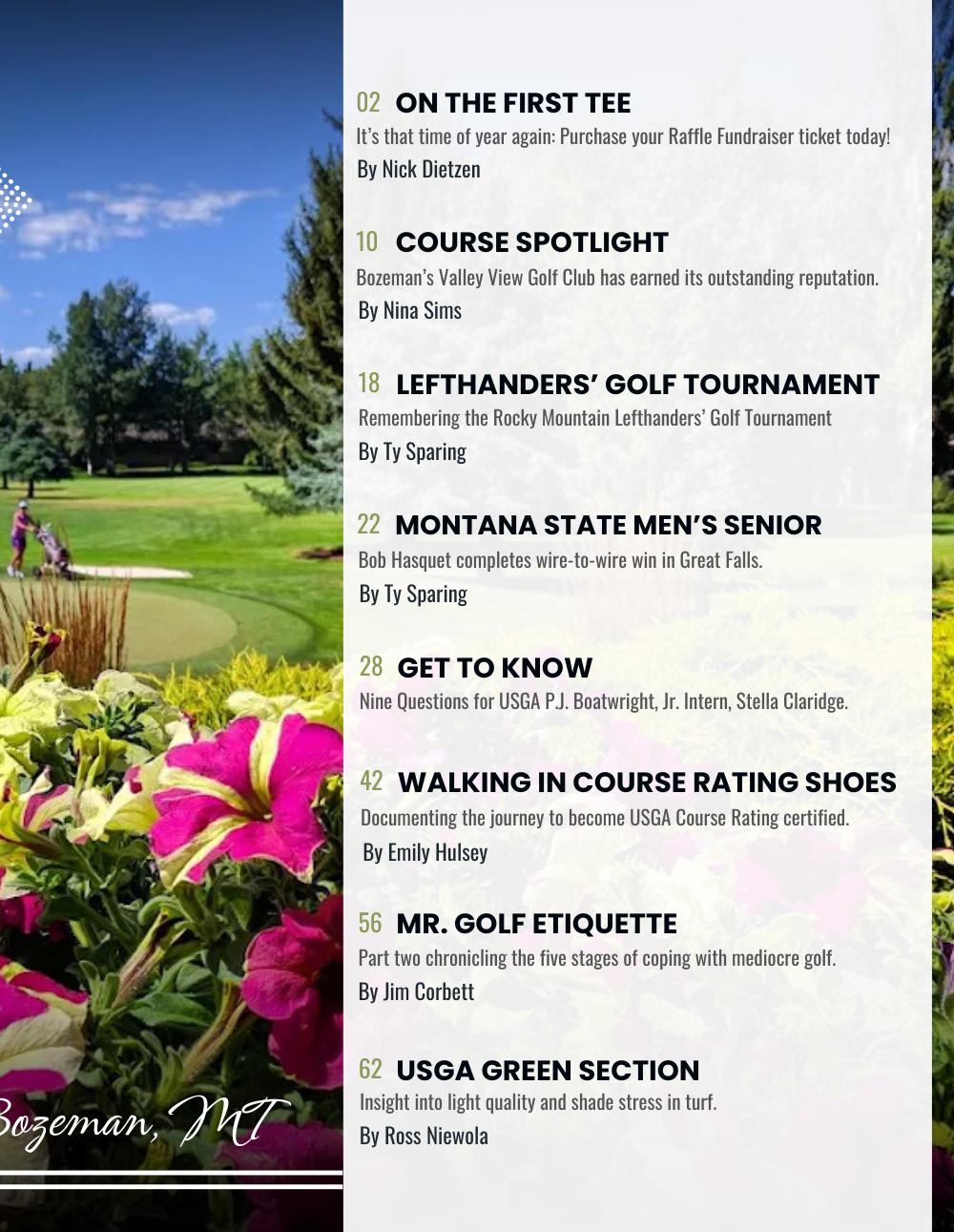





BY NINA SIMS FOR VALLEY VIEW GOLF CLUB
Close to the end of World War II, Jeanne Roby met and married a US serviceman in Cambridge, England. It was 1944 and she was 21 years old. When the war ended, she and her husband, Harold, moved to their new home in Bozeman and joined Valley View Golf Club. But it was a far different golf club than it is today.
The Club, which was already established when Jeanne arrived on the scene, was located on the property which today is euphemistically known as “Nob Hill”. The boundaries were South Church, Kagy (which at that time was nothing more than a dirt lane), and Highland Boulevard.
The first hole started at the bottom of the hill on Church, and the golfer reached the green by hitting uphill all the way to a dog leg to the left built into the side of the hill. The second hole was at the extreme top of the hill. There were no powered carts in those days; indeed, there were no pull carts. So, golfers carried their clubs, and occasionally their infants in a carryall, to navigate the course. Jeanne remembers carrying a 2, 3, and 4 wood, a 5, 6, and 7 iron, a mashie and a putter in a canvas bag. Eventually pull carts came into being which made golfing much easier.
Caring for the green was no problem. They were made of sand. Before putting a scrapper was dragged between the ball and the hole so putting could take place on a smooth surface. The members would
periodically oil the green to enhance the putting surface.
The log clubhouse was located on South Church. It had a deck, which wrapped all the way around and when dances were held, the members would dance around the clubhouse on the deck. Some years later this structure was sold, converted into a home, and is still in existence.
The membership, composed of less than 60 people and was a young group. Many of the men had returned from World War II and were embarking on new careers or attending MSU on the GI Bill. The Golf Club was the focal point for much of their social life. There were parties, Sunday breakfasts prepared by members, dances, bridge games, and a women’s golf group, which played on Tuesdays, just like today.
The dues were very reasonable, around $15 annually. Revenue was derived from dues and slot machines in the clubhouse and members did much of the work that needed to be done.
When the decision was made to move the club to its present location, the members were ambivalent. The close-knit group knew they were going to miss the camaraderie and good times they had at the old location. But they looked forward to the new and better course and clubhouse.
In the mid-sixties visionaries in the golf club saw the advantage of moving from Kagy and Church to the present location on Kagy. In order to finance the move, the land on which the old course was located was traded to Gene Graf for bottomland on Kagy plus options on other parcels.
In the beginning it was a nine-hole course
with a driving range on Kagy to the right of the present Club House. At first the clubhouse was a trailer but anxious to have their own club house, the members decided to build one. The members donated the majority of the labor and many of the fixtures were contributed also. The men did most of the building on Saturday and the wives took dinner to them so they could get as much finished as possible. All the members did a variety of things to raise money for equipment and for appliances.
In the meantime the course was taking shape. About that time the City decided to make Kagy a proper street and much of the dirt and gravel removed to form the ponds and lakes are part of the roadbed of Kagy.
At that time, like today, Bozeman was experiencing a drought and the biggest problem was getting the greens to grow. Harold Roby, along with others, hand watered the greens. Finally, members from MSU used their agri-

cultural expertise to reseed the greens. This resulted in grass but also in weeds, which had been mixed in with the hay used as cover to keep the seed moist. This meant that members met to hand weed the greens and, not incidentally, an excuse for another potluck party.
Another problem was rocks. There were rock sessions, but no music was involved. Members, including children, would go down the fairways and pick up rocks. The success of their labor is apparent today as one plays down the fairways.
All of these things served to pull the already close-knit group tighter and, although it was hard work, it was great fun. The members resumed their Sunday morning breakfasts, dances, dinners, and bridge parties. Their social life again revolved around the club and since the club didn’t have a liquor license, members brought their own bottles. After several surprise visits, the inspector finally warned the members they would have to have a liquor


license or suffer the consequences. Fortunately, through the intervention of a friend of the club who “happened” to be on the Liquor Board, an open liquor license was granted to the Valley View Golf Club.
For ten years it was a nine-hole course, however, realizing there would have to be 18 holes in order to be a viable golf course, plans were made. Ultimately it took several years and lots of work to reach that goal. The driving range was sold and the money was used to help finance the construction of the additional nine holes. Again, the members donated their time and labor to reach this goal. Dana Schrupp planted the willow trees to the right of the driving and left of current Hole #1. The trees, which were veritable sticks when he planted them, are now tall willows. And, once again, the membership turned their attention to raising money.
At that time a high-level conference of Naval personnel and others, including such notables as Wernher von Braun, was scheduled to be held in Bozeman. Betty Babcock, then the Governor’s wife, asked Jeanne to chair a
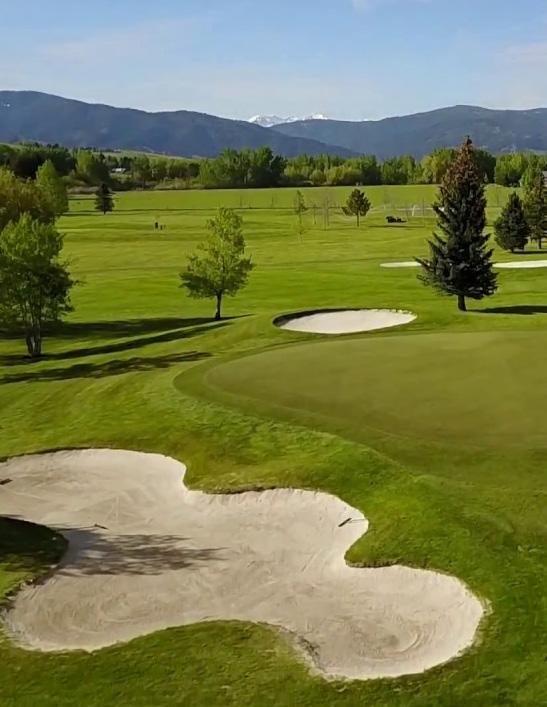
social committee which would entertain the wives. Naturally, one of the activities Jeanne arranged was a cocktail party at Valley Golf Club for the men and their wives. Jeanne remembers seeing the hat rack, which looked like a sea of gold braid. Ray and Kay Campeau set up several bars around the 9th hole and together with the women of Valley View, served drinks and hors doeuvers, which the women had made. Mrs. Von Braun requested a cup of hot tea and there was a bit of a scurry as someone made a run to the store to purchase tea. The party was a success and Valley View had more money for their expansion program.
Today Valley View is a beautiful and challenging course with a nice clubhouse and all the amenities. But ask Bill and Lou Ogle or Dana and June Schrupp about the old days. Like Jeanne, they will probably tell you that nothing can replace the grand times and camaraderie they had when they were young and full of life. The times when, like mountain goats, they used to trudge up and down the old Valley View Golf Course, all for the love of golf.
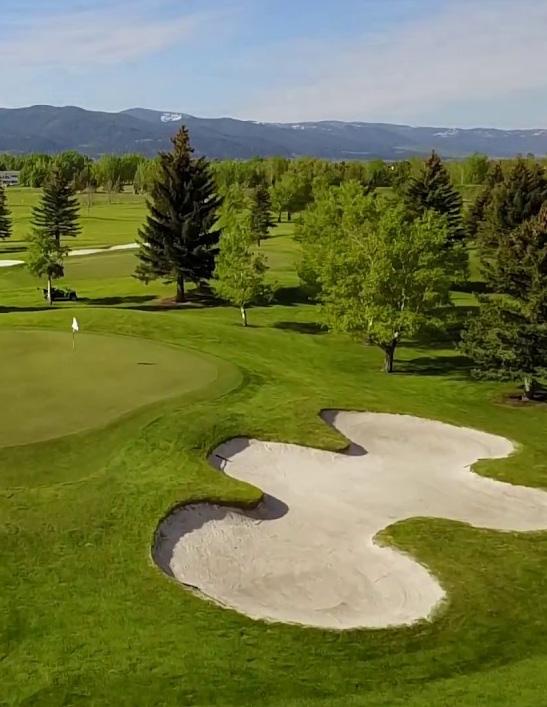



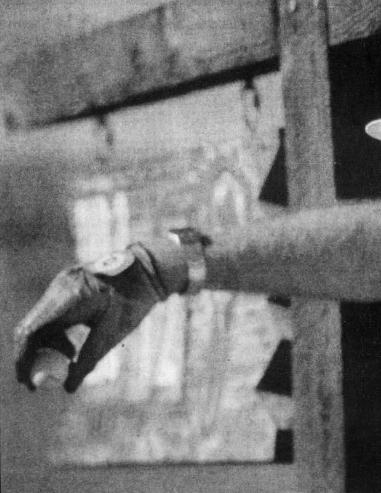
BY TY SPARING MSGA Communications Coordinator
Back in 1962, the Valley View Golf Club in Bozeman hosted one of the quirkier golf tour-
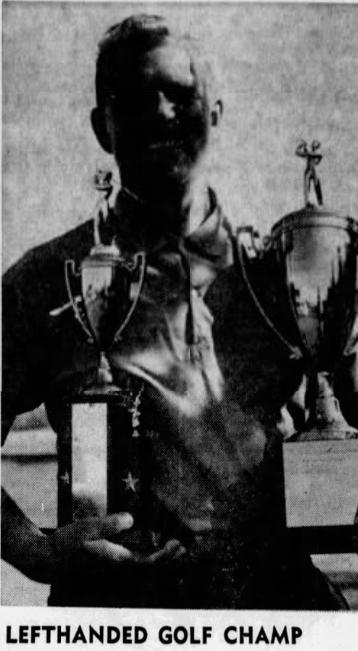
naments you’ll ever hear about, an event initially dubbed the “Montana State Lefthanders Amateur Golf Tournament.” Having just completed a beautiful brand-new all-grass course down the road from its original location, the folks at Valley View were eager to show off their new spot and prove its merit as one of Montana’s newest tournament locations.
People weren’t sure what to make of a golf tournament for southpaws however, as one writer for the Montana Standard noted, “No advance predictions for this first tournament can be made since it is not known how many ‘wrong-side’ golfers there may be in Montana.” With a barbecue and entertainment planned for the two-day event, lefthanded camaraderie among the unique cohort of golfers was likely at an all-time high. Winning the inaugural Lefthanders Tournament was Livingston’s Joe Grundhauser
Gimmicky perhaps, but that first Lefthanders Amateur Tournament proved to be a success and became a beloved annual tradition for over three decades. Just a year later in 1963, the field was opened up to golfers from outside of Montana, attracting players from all over the country and Canada. By 1965 the event was rebranded to the Rocky Mountain Lefthanders Golf Tournament, and that’s how it would be for the next thirty years.
For the first six years of the event Valley View Golf Club proudly hosted the contingent of goofy-foot golfers, beyond which the Rocky Mountain Lefthanders Golf Championship rotated around a number of high-quality Montana courses like the Butte Country Club,
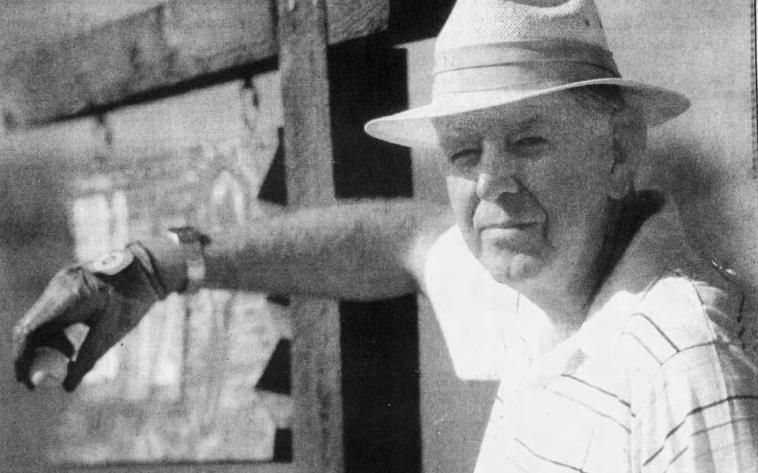
Yellowstone Country Club, Pryor Creek Golf Club and the Hamilton Golf Club.
The Lefthanders Tournament started out as a whimsical, tongue-in-cheek type of competition for those afflicted with the “clumsy hand.” Keep in mind that most of the golfers competing in the early 1960s likely had childhoods where they could get their hands slapped by a ruler for writing left-handed. It wasn’t just about handwriting either, as prejudice against left-handers went back millennia. The word “Sinister” is Latin for “Left,” and religious communities over the years have associated left-handedness with witchcraft and the devil. Being so taboo in this era, these first tournaments at Valley View probably functioned like a left-handed support group. That and a good way to find connections for some lefty clubs. While an ironic whimsy remained a part of the culture of the event, it became pretty obvious to observers that these left-handed golfers were actually pretty good, some commentators
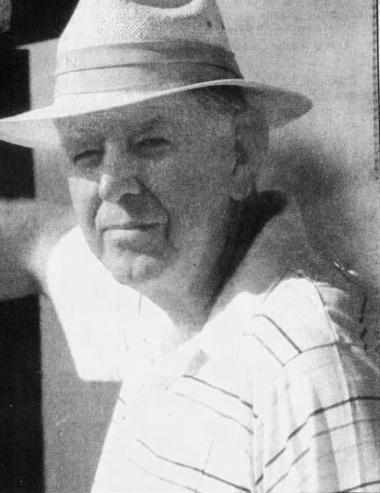
even started to wonder why they deserved special treatment. “Who said lefties are at a disadvantage?” one writer for the Montana Standard wrote in 1974, “They put on their pants the same way. Or do they?”
As the first twelve years of the Rocky Mountain Lefthanded Tournament showed, southpaw golfers were every bit as talented as their right-handed peers. “So, if left-handers can beat you single-handedly,” the Montana Standard writer continued, “why do they have to band together for their own golf tournaments? They all seem to come out of hiding for the lefty tournaments.”
Joe Grundhauser won three early lefty titles, but it was the towering George Michotte that would go down as the most decorated Rocky Mountain Lefthanded champion of all, winning the tournament thirteen times and coming in second nine times. Michotte, who stood at 6’7”, only came to play golf at the age of 32 after spending a few years playing minor
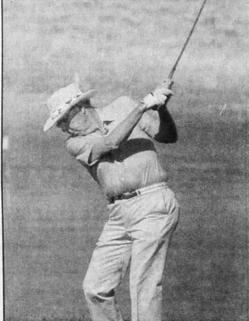
league baseball for the Philadelphia Phillies organization.
“The key to this tournament,” the former hard-throwing pitcher told the Billings Gazette in 1989, “is keeping the ball in the playing area and putting is also very important.” Not exactly advice unique to left-handers.
Like a lot of left-handed golfers of that era, Michotte started off playing right-handed due to the fact that he couldn’t find any left-handed clubs. Once he was able to acquire a proper set his handicap went from 15 to 3, and he was off to the races, appearing in high-level tournaments like the Phoenix Open and the Las Vegas Sahara Open. The Rocky Mountain Lefthanders Championship came at a perfect time for Michotte who essentially cornered the market of southpaw golf in this region of the U.S., having dominated the competition for over two decades. “The way Michotte used to play,” one Billings Gazette writer stated in 1989, “the Rocky Mountain may as well have been called the George Michotte Invitational.”
When asked his thoughts on being a lefthander, a wry Michotte responded, “People always make fun of left-handers, but I just tell them I belong to the largest non-violent minority group in the world.”
By the mid-1990s the Rocky Mountain Lefthander Tournament started to lose steam and before long was just another memory of a bygone era. The “inside joke” of the event was reduced to a hollowed-out tradition, and without deeper meaning it failed to thrive and live on. Perhaps the novelty wore off after all those years, with new generations of left-handers being brought up on ambidextrous scissors and school desks and able to find left-handed clubs and other items much easier. Plus, people stopped associating lefty status with the devil—now left-handers are considered just “regular people” with no innate tendencies towards the occult.
Whatever the case, the memory of the Rocky Mountain Lefthander Golf Tournament
is just another example of how golf can draw in the most unique groups around for all types of celebrations. To all our lefthanded MSGA golfers out there, we wish you a belated Happy International Lefthanders Day (AUGUST 153)!
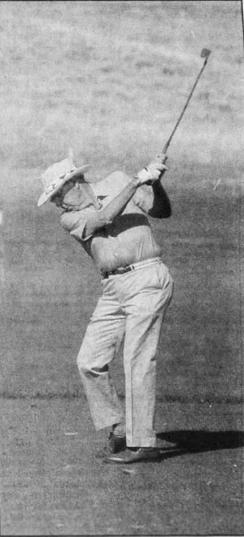


BY TY SPARING MSGA Communications Coordinator
Missoula’s Bob Hasquet secured a wireto-wire victory at the 70th Montana State Men’s Senior Tournament earlier in August as he cruised to a six-stroke win, his very first State Senior title. Hasquet managed to hold off a field full of past title winners and MSGA Hall of Famers, along with a bit of rain over the week, as he went on to finish as the only golfer under par at -3 (144) over the three-round event.
Coming into the final round with a two-
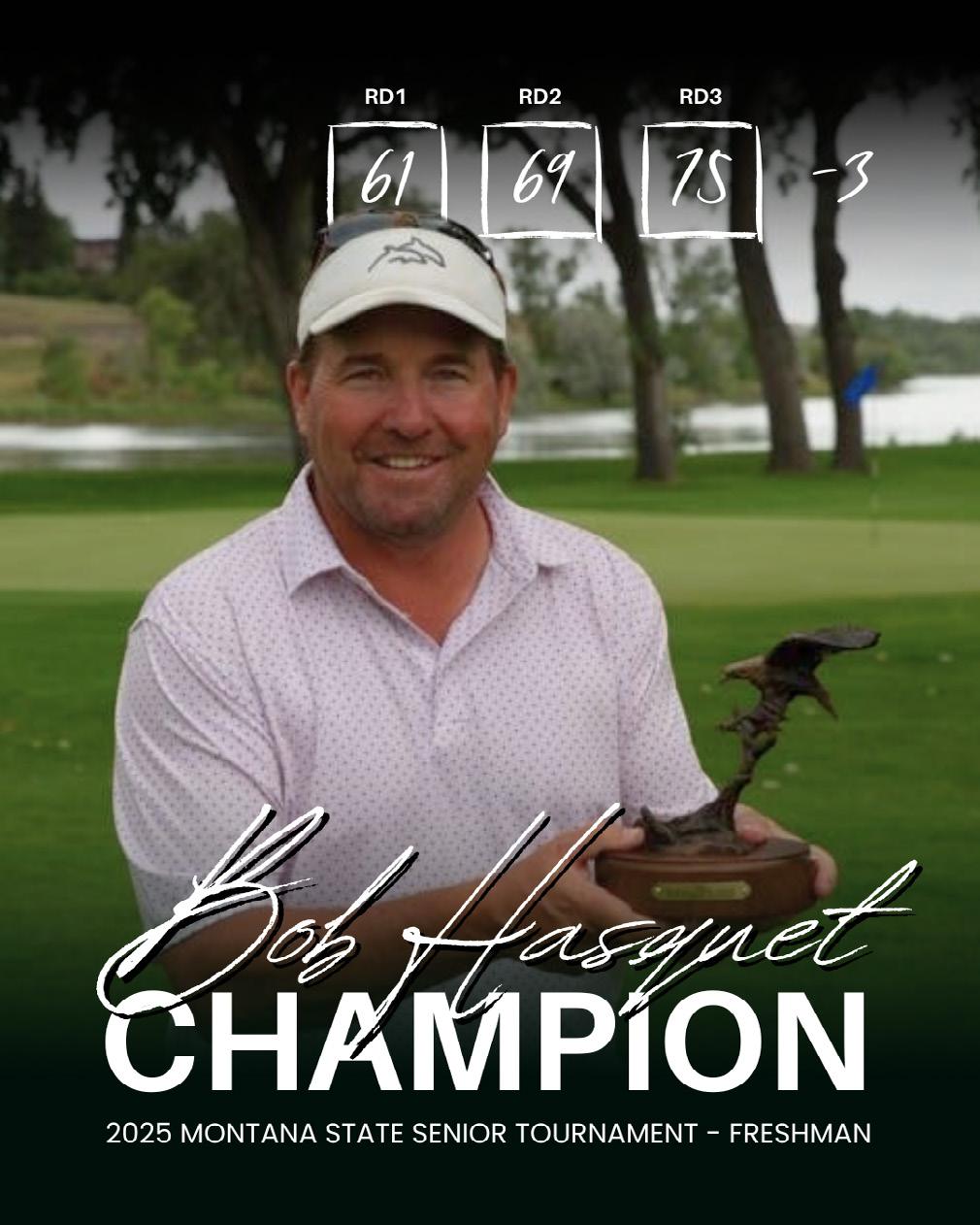
stroke lead over two-time State Senior Titlist (2021, 2023), Bill Dunn, Hasquet knew he would have to stay sharp to keep himself in the top spot. Registering three birdies over the course of the round, Hasquet managed to finish at +3 (75), which on a day where scores were inflated due to inclement weather, was the third lowest round in the field on day three. With a few untimely bogeys, Bill Dunn wasn’t able to put significant pressure on his fellow Missoula playing partner, ultimately finishing in a tie for second place with Brad Grattan (Whitefish) at +3 (149) overall. 2022 State Senior Titlist, Grattan, scored -3 (69), which was the lowest single round score of the day but not quite enough to catch up with


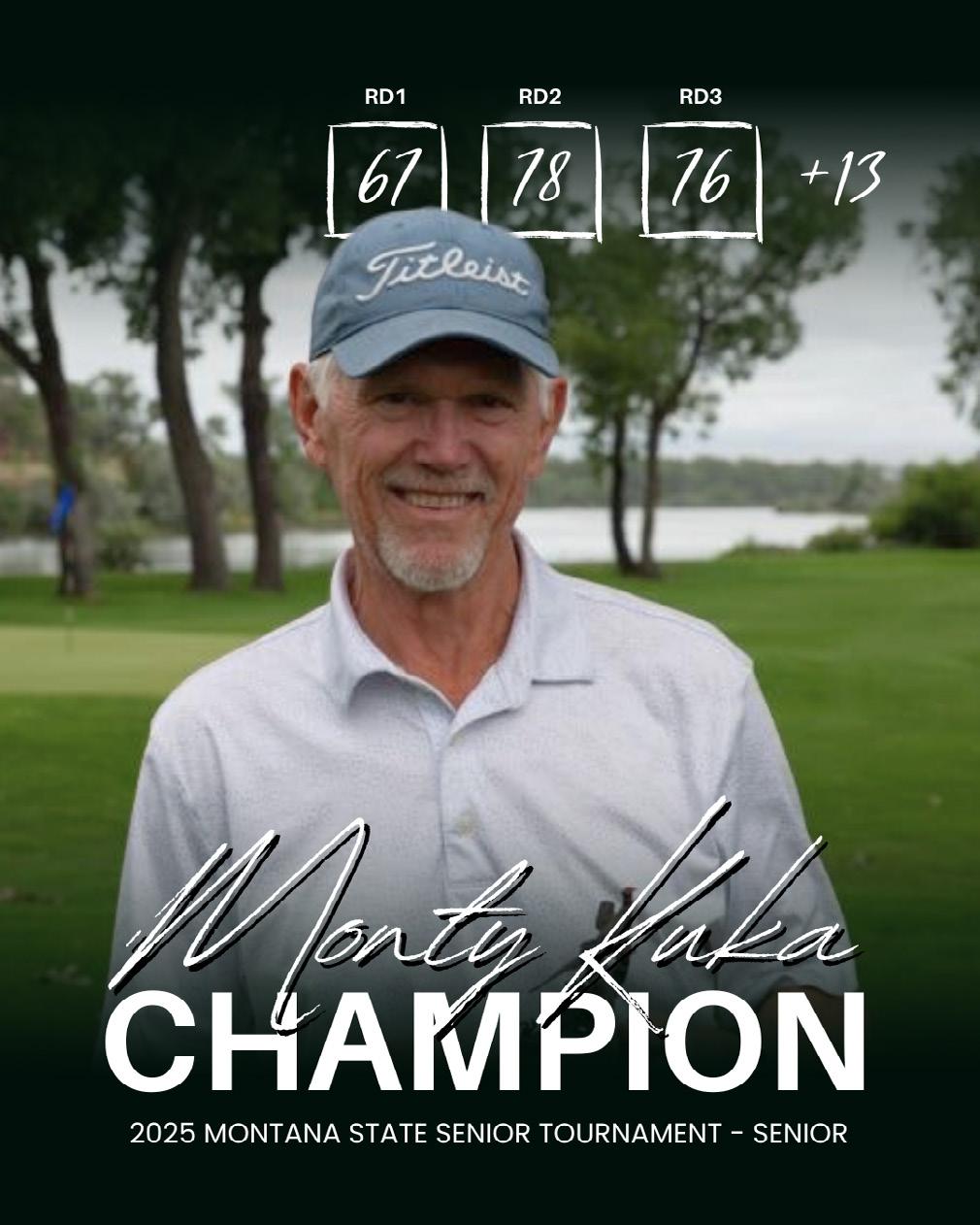
Hasquet.
In fourth place at +5 (141) was Kelly Knievel (Butte) and in fifth place at +7 (148) was Jay Anderson (Helena).
In the Freshman Division (ages 55-62), the top three remained the same, with Todd Sisson (Bozeman) coming in fourth at +8 (150) and Matt Sheridan (Missoula) finishing in fifth place at +9 (147).
Kelly Knievel took home the top spot in the Sophomore Division (ages 63-69), followed by Lee Levine (Bozeman) in second at +14 (155), Todd Harper (Great Falls) in third at +15 (156), Gene Walsh (Whitefish) in fourth at +16 (152) and in fifth place was Marshall Bettendorf (Ennis) who finished at +17 (157).
The Junior Division (ages 70-77) was led by Jay Anderson in first place, with Dave Stengel (Missoula) and Terry Vanderpan (Billings) tied for second place at +12 (153), Doug Olson in fourth at +14 (156) and Bruce Scott (Kalispell) ended in fifth place at +16 (160).

Monty Kuka (Great Falls) won the Senior Division (ages 78-84) at +13 (154). Kuka was followed by Tom Hall (Great Falls) in second at +16 (156), Dave Streeter (Whitefish) in third at +23 (160), Jim Schaible (Helena) in fourth place at +24 (166), and in fifth place was Robert Cummins (Missoula) at +30 (162).
The Super Senior Masters (ages 85-88) had perhaps the closest battle of the six divisions, as Missoula’s Norman Carey managed to overtake fellow Missoulian and past winner in the event, Glenn Kozeluh. Carey finished his three rounds at +77 (194), while Kozeluh ended up at +82 (202).
In the Super Senior Legends (89+), Bob Miller (Butte) led write-to-wire to win the division at +75 (198).
Note: An updated leaderboard can be found online at www.msgagolf.org as well as through the Golf Genius App via GGID: 25MSGASS
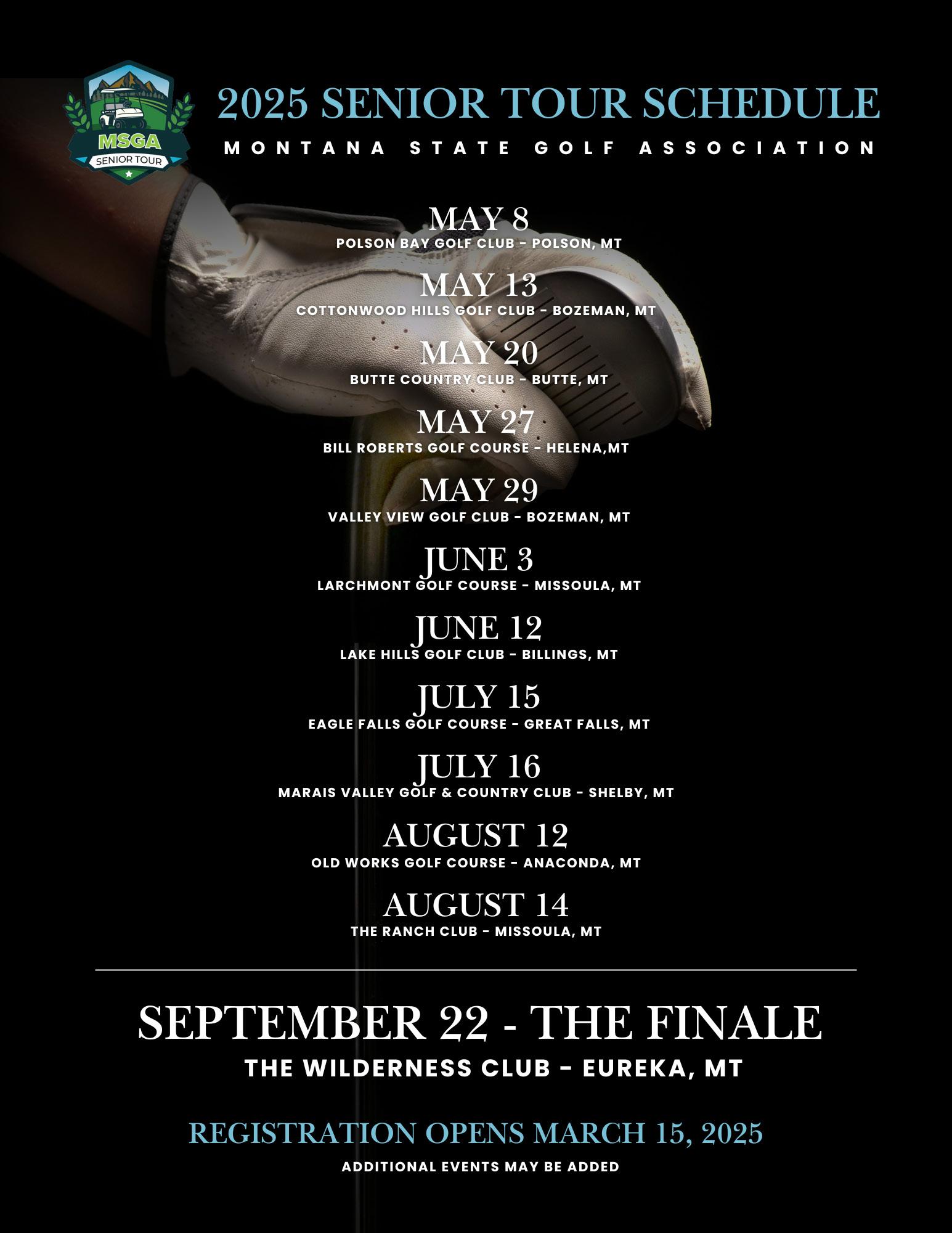

BY NICK DIETZEN MSGA Executive Director
The 2025 Montana Cup proved to be one of the most competitive in its illustrious history as the Amateurs retained the Cup by virtue of a slim, two-point victory (37-35). Green Meadow Country Club in Helena hosted the annual event featuring 12 of the top PGA Professionals in the State and 12 of the top amateurs representing the MSGA in a Ryder Cup-Style Match with two days of competition and 54 holes.
Day one featured 18-hole Four-Ball Matches (best ball) and 18-hole Modified Chapman (explanation at the bottom of the article) Matches. Day two had 12 singles matches. All matches were worth three points, one point for the front nine, one point for the second nine and one point for the total.
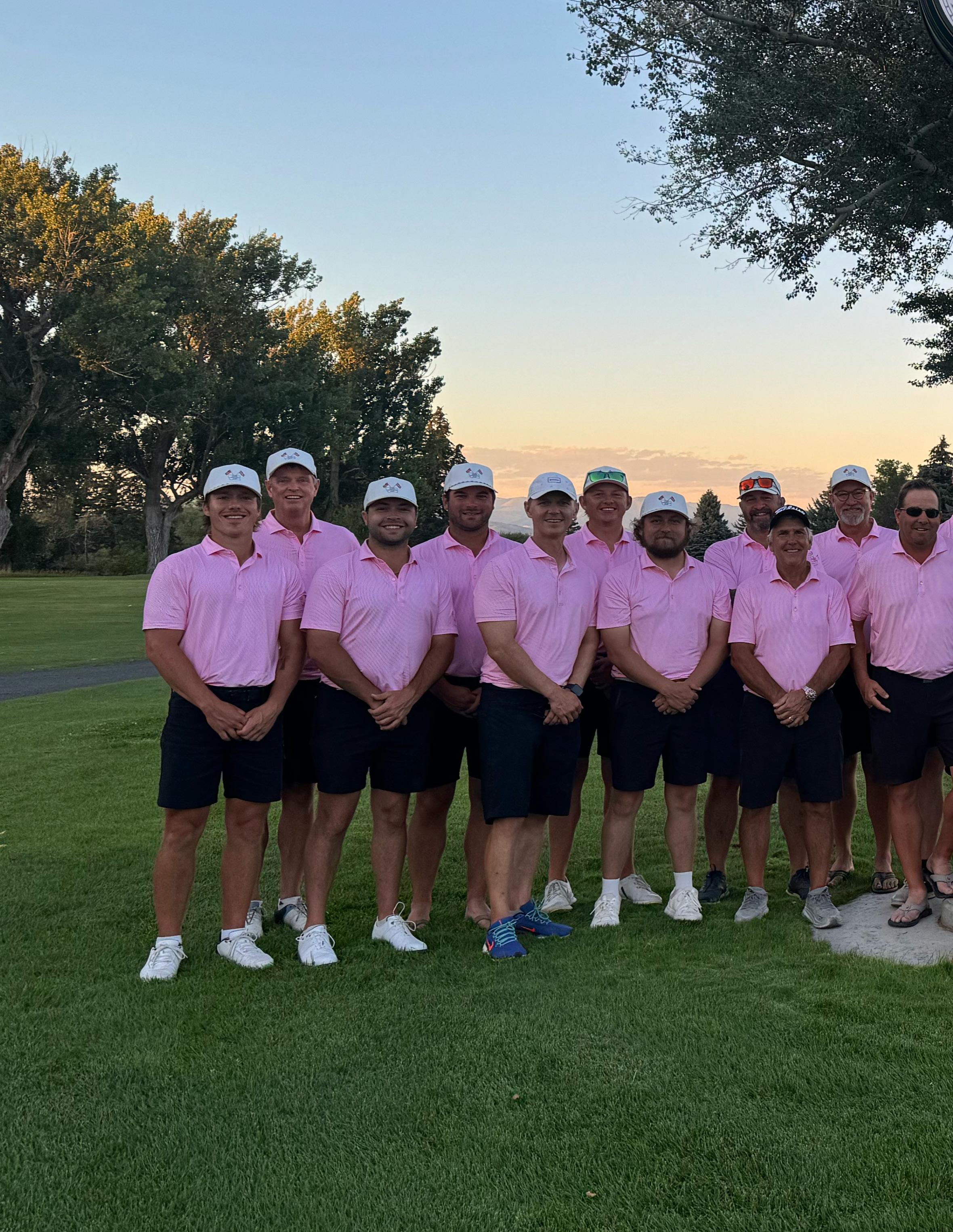
Day one saw the professionals jump out to a 12.5 to 5.5 lead in Four-Ball Matches with Ryan Malby (Iron Horse GC) and Liam O’Halloran (Lake Hills GC) claiming 3 points as well as Chad Carlson (Green Meadow CC) and Jess Roper (Buffalo Hill GC) earning 3 points. In all, four of the matches went in favor of the professionals.
In the afternoon Chapman Matches, the amateurs – who prevailed last year at Old Works – reversed their fortune winning 12-6 thanks to four matches in their favor, paced by Helena’s duo of Spencer Williams (Green Meadow CC) and Nicholas Balcken (Bill Roberts GC) who swept all three points in their match to pull the margin to one point (18.517.5).
Day two saw 12 singles matches between the professionals from the Western Montana and Yellowstone Chapter Professionals and the
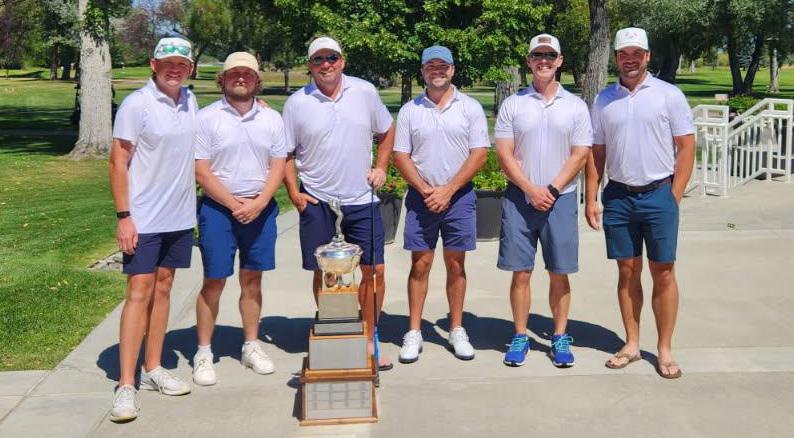
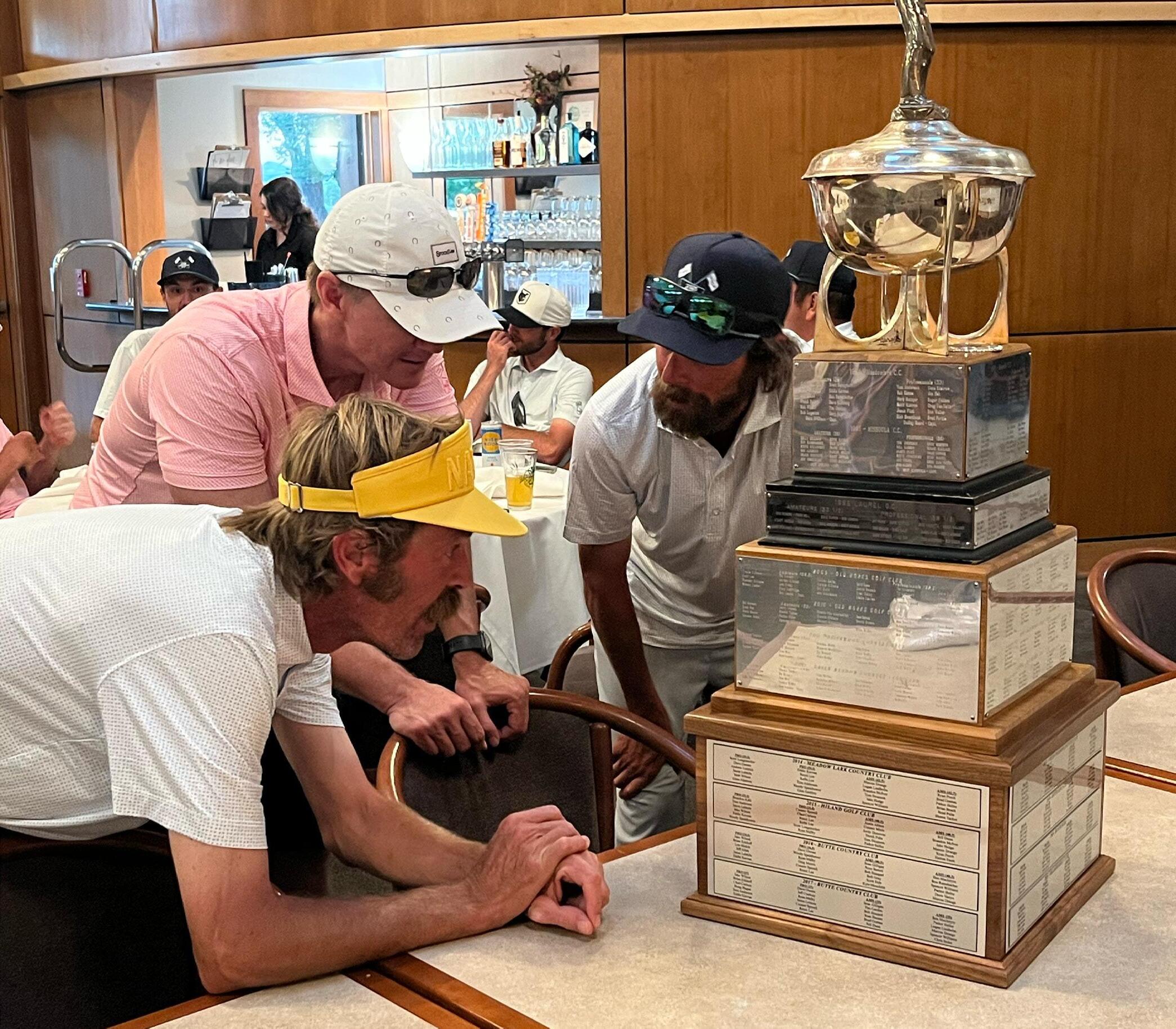
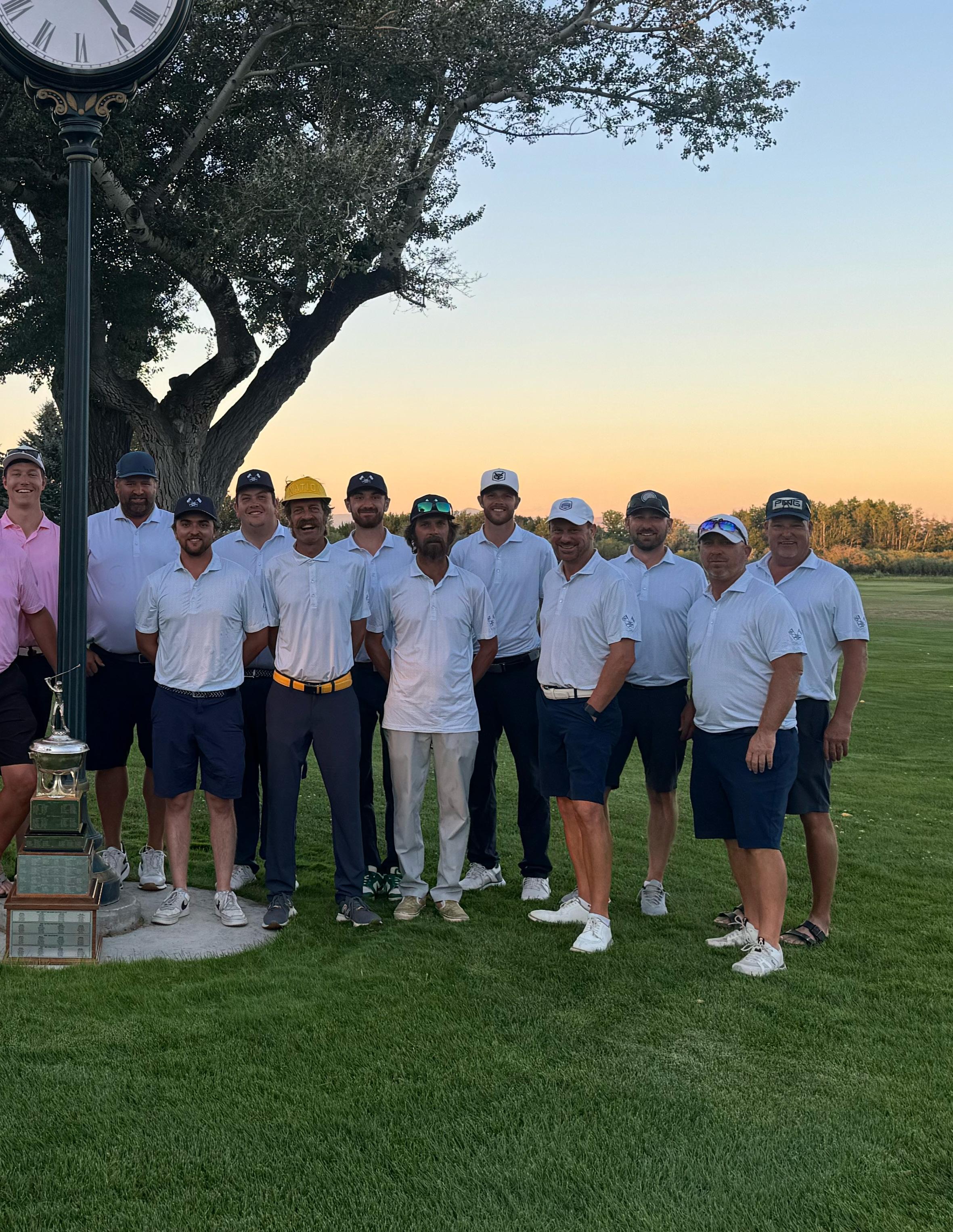
amateurs who earned points through a multitude of events over the past season. The amateurs won 7 matches, the professionals won 4 and one match tied to determine a razor-thin margin of 37-35 and the amateurs retaining the cup. Helping the amateurs reach their 37 points via singles were three point wins by Williams, Samuel Berry (Yellowstone CC), 2.5 points from Ben Kaul (Eagle Falls GC) and Sam Boyd (Canyon River GC). Keeping the professionals close were O’Halloran, David Owens (Missoula CC) and Malby with three points each.
Representing the amateurs were: Williams,
Balcken, Berry, Boyd, Kaul, Brad Grattan (Whitefish GC), Sean Rambsbacher (Missoula CC), Liam Clancy (Laurel GC), Bob Hasquet (Missoula), Ryan Flink (The Ranch Club), Bill Dunn (Missoula CC) and Todd Sisson (Cottonwood Hills GC).
Representing the professionals were: O’Halloran, Owens, Malby, Roper, Carlson, Renzi Lee (Lake Hills GC), Kelbi Lee (Big Sky GC), Travis Wright (Green Meadow CC), Jason Lehtola (Whitetail GC), Garrett Woodin (Hilands GC), Jake Wilson (Hamilton GC) and Chris Lien (Yellowstone CC).
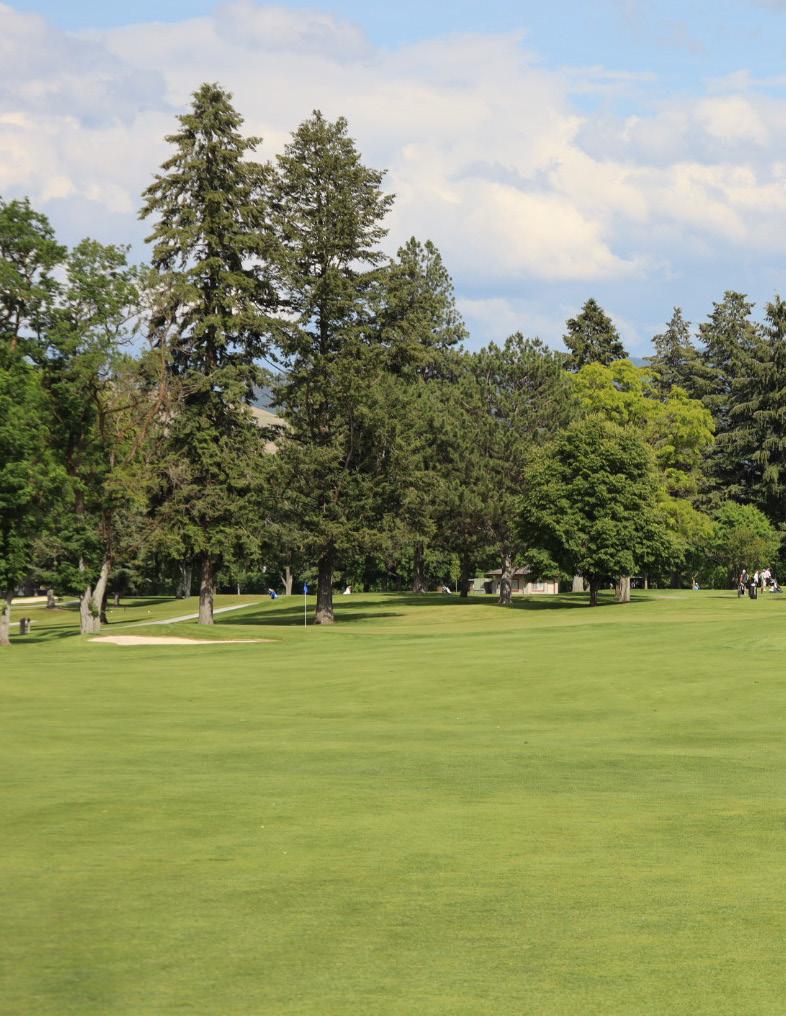

1. Who introduced you to golf?
My parents introduced me to golf when I was around 3 years old. I remember the day my dad came home from work and had a yellow and black set of club in his hands for me. They were far too big but it was the smallest they came at the time. My mom has plenty of videos of me trying to swing the driver in the backyard. My whole family, on both my moms and dads side of the family are avid players. My great grandma on my dad’s side could still shoot her age at 85 and had nine hole in ones… I’m convinced her and my grandpa, who has 5 on his resume, stole them all from future generations because my dad and I have yet to get one. Needless to say, I was bound to touch a club at some point.
2. Who influenced you most in your golf life?
Similar to my last answer, my parents influence me most when it comes to golf. I can always count on my mom to ensure I’m the best dressed on the course and be there for me when I have a bad round. When it comes to the game itself, my dad has spent more time on the course with me than anyone else. He has basically taught me everything I know. Though I have many different coaches now, my dad is still the one I fall back on.
I cannot discount the amount of time my
coaches have put into my game. People like Jim Schaible are not just mentors, but lifetime friends now. I have been blessed with some great people in my life to I owe all the credit to. I wouldn’t be where I am without them.
3. What is your favorite memory while playing golf for Carroll College?
My favorite Carroll College golf memory was last year when the girls team broke the school record. Nothing compares to the feeling of leaving your mark and accomplishing a milestone like that. The women’s team put together the best two-day event in program history with a score of 309-314. I am so glad I was a part of that feat and hope to do it again this coming season!
4. What is your favorite course in Montana and why?
I have a few different courses that I love in Montana for a few different reasons. My all time favorite, contrary to most people’s opinions due to the difficulty and uncertainty, is Buffalo Hill. It is near and dear to my heart. It’s the course I spent my childhood on and have learned to love the game on. Without the Buffalo community, I probably wouldn’t have ever played competitively. They introduced me to a whole new world
of golf by giving me lessons, hosting kids camps, and allowing me to be on the junior PGA team. No course has come close to environment that Buffalo exhibits. Besides Buffalo, I am also a member at Eagle Bend which is a beautiful course and probably one of the most pure in the state. The practice
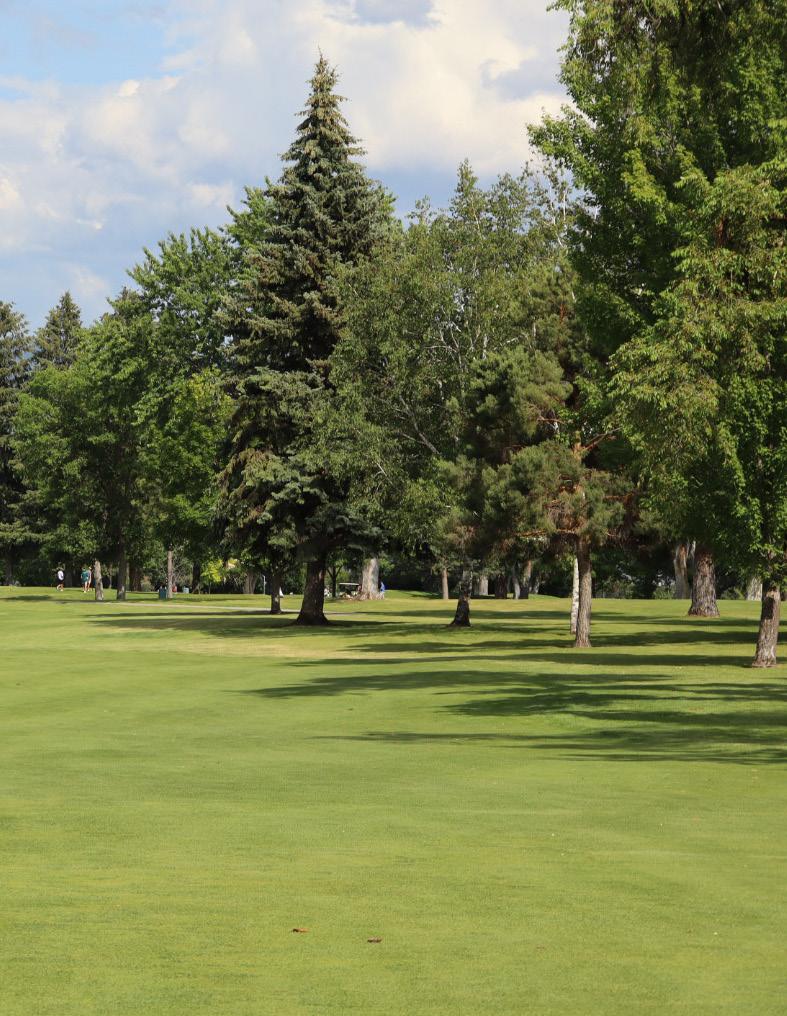
facilities are impeccable and the course is always so well maintained. It’s great. Lastly, although I’ve only played it once, I have to give a shoutout to Stock Farm. It is one of the most gorgeous, scenic courses. I would love to play it again someday.


5. What is a dream golf course you’d like to play once?
Although it’s cliché, I want to play Augusta. Something about the azaleas and how much history there is draws me in. Unfortunately, my chances are near zero. A dream public course would have to be Pebble Beach. I love scenic golf and that course is top tier.
6. What is your dream celebrity foursome (living or dead)? Why would you choose them?
My dream foursome would be my dad, John Daly, and Bryson DeChambeau. If you were to ask me this question in a month then I’m sure my answer would be different. It’s constantly changing because there’s so many people I’d love a round with. No matter what I want to play with my dad because we have a bucket list goal of playing golf in all 50 states and I know those pros would have some awesome connections. Plus, I cannot experience that without him. I chose Daly and DeChambeau solely because I know it would be an absolute blast. It would be so entertaining and I’d take that over a serious round any day. There would be lots learned but I can also imagine the conversations and how easily they would flow. Perhaps I’d even make it on Bryson’s YouTube channel. Overall, they’d be a good time and that’s most important to me.
7. What’s your most memorable moment on a golf course?
My most memorable moment was not necessarily a good one, but it sure does make a great story. I was a junior in High School playing the MHSA State Tournament at Missoula Country Club. I was 9 holes in and just totaled up the front when I realized that I was on track to shoot my
best round ever at the time. I get to hole 10, hit a beautiful drive center of the fairway and hit my second shot right in front of the water guarding the green. When it comes time to hit my third shot, I chunk it in the water. I obviously am a bit frazzled but talk myself out of the negative mindset. I drop and hit my next shot. That one goes into the water too. Fast forward, about 4 more shots go into the water. I finally make it over and I’m in the bunker above the green. Coming out of the bunker, I hit back into the water. Finally, I’m on the green where I two-putted for a 16. It was quite the chain of events to say the least but I got through it without crying so I’ll take that as a win. My goal after that day was to be all-state my senior year. I improved 11.5 strokes going into my senior season and ended up reaching that goal!
8. If you could change one thing about the game of golf what would it be?
If I could change one thing, it would be getting relief from fairway divots. Why should I have to deal with the consequences of a topped ball because someone else was too lazy to put their beavertail back or fill their chunk with sand?
9. What advice would you give to beginner golfers?
My biggest piece of advice to beginners would be to put the work in if you want to see improvement. Nobody is naturally good at golf, it’s all about who practices the most. If you have enough grit then you’ll be successful.
Bonus: Lay up or go for it?
Layups are for basketball. Go for it!!!



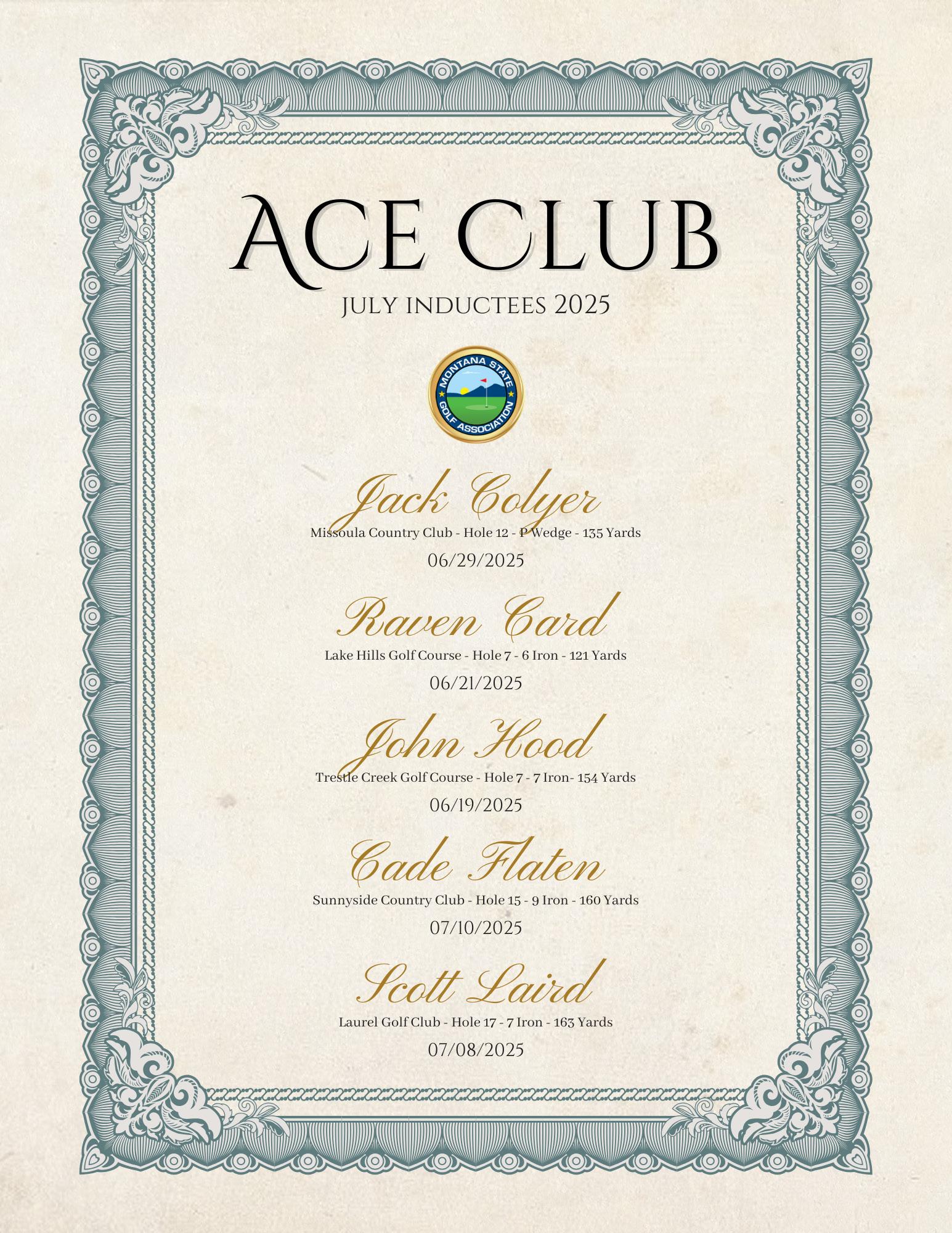


The University of Montana golf team bolstered it’s depth recently after adding Salina Lui from Sandy, Utah. Lui played golf for Utah Tech during the 2022-23 season before going on a two-year mission. Now back and ready to get back in the game, Lui contacted Head Coach Jimmy Mee last month about coming to Missoula. Given that her swing speed reaches
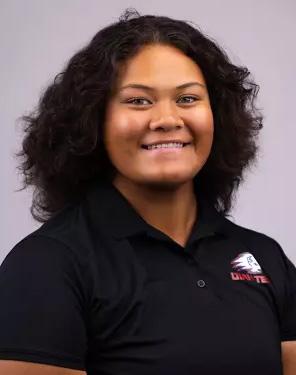
110 miles per hour, Mee was interested. “We can teach her course management,” Mee told a Montana Sports Information reporter, “but we can’t teach someone to swing it 110.”
With the addition of Lui this fall, the Griz will have eight on the roster, including the 2025 Montana State Women’s Amateur Champion, Raina Ports, along with incoming freshman Katie Lewis who is the three-time reigning female titlist at the Montana State Junior Championships.
On a piece of ranch land near Twin Bridges that has, let us say an interesting past of previous owners, the former Wyoming Landowner of the Year, Buzz Warner, has been constructing a new Scottish-style links 18-hole golf course since last summer. As recently profiled by David Madison for the Wyoming newspaper, Cowboy State Daily, Warner cited the “lack of golf in Madison County” for why it was an “easy decision” to build a golf course on land he acquired in 2019 after selling a family trucking business.
Naturally the locals were skeptical at first, especially in light of uber-exclusive luxury ranches like Crazy Mountain Ranch and Yellowstone Club, who have been beset by a bevy of water and sewage related legal scandals. But
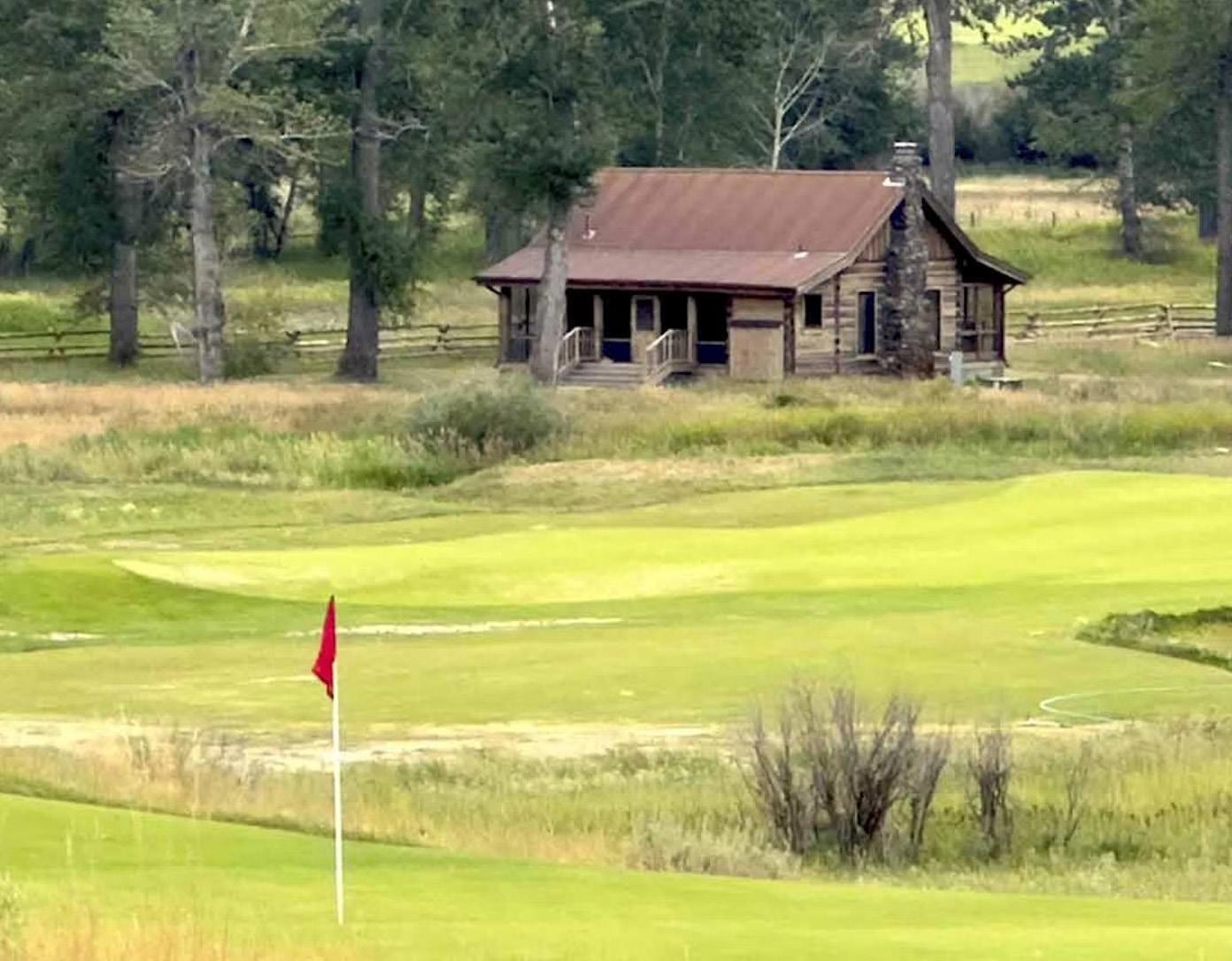
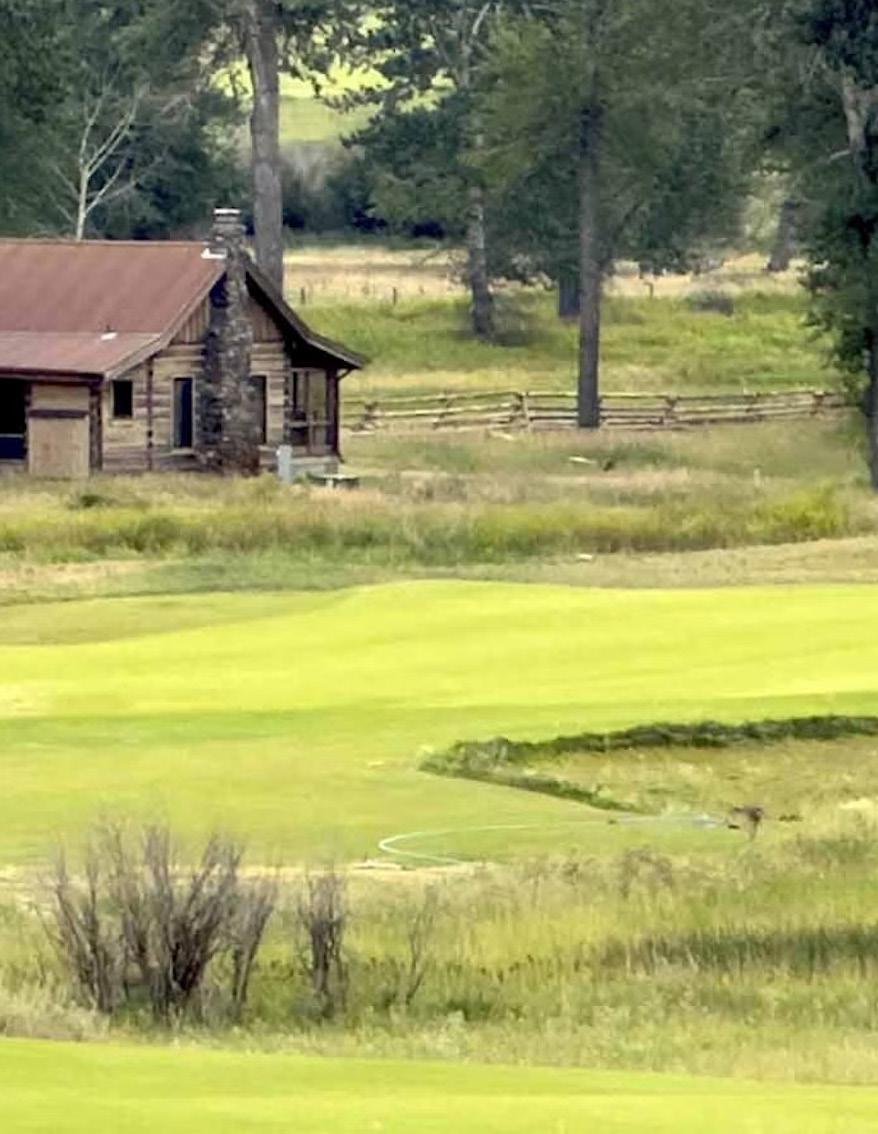
with a promise to let locals play for free one day a week, and offering to host high school events, Warner has seemingly presented an alternate vision for how a golf course on pristine Montana ranch land can operate.
This seems to fit in with Warner’s conservation background as the 2019 Wyoming Landowner of the Year, an award received for his work at the Sage Creek Ranch in Uinta County. The Wyoming Game & Fish Department noted that Warner produced “one of the most wildlife-friendly landscapes in Wyoming,” and that “the amount of time, money and effort Mr. Warner has given to the wildlife of Wyoming in just 10 years far exceeds what most people do in a lifetime.”
So far, the Montana results for the golf course pursuit have been mostly positive, as a representative for the Big Hole Watershed Committee has already come out and claimed that Warner is following all Montana water laws and stated that if anything “it’s looking like there’s going to be a net conservation of water.” Interestingly, in converting the land away from growing hay, Warner was able to close an irrigation intake ditch, which results in “3 million gallons of water a day remaining in the [Big Hole] river and not used for ag irrigation.”
The course, which is now also considered a bird preserve, was previously owned by former Secretary of Defense, Donald Rumsfeld, who
AUGUST 15, 2025 - 406GOLF - 35
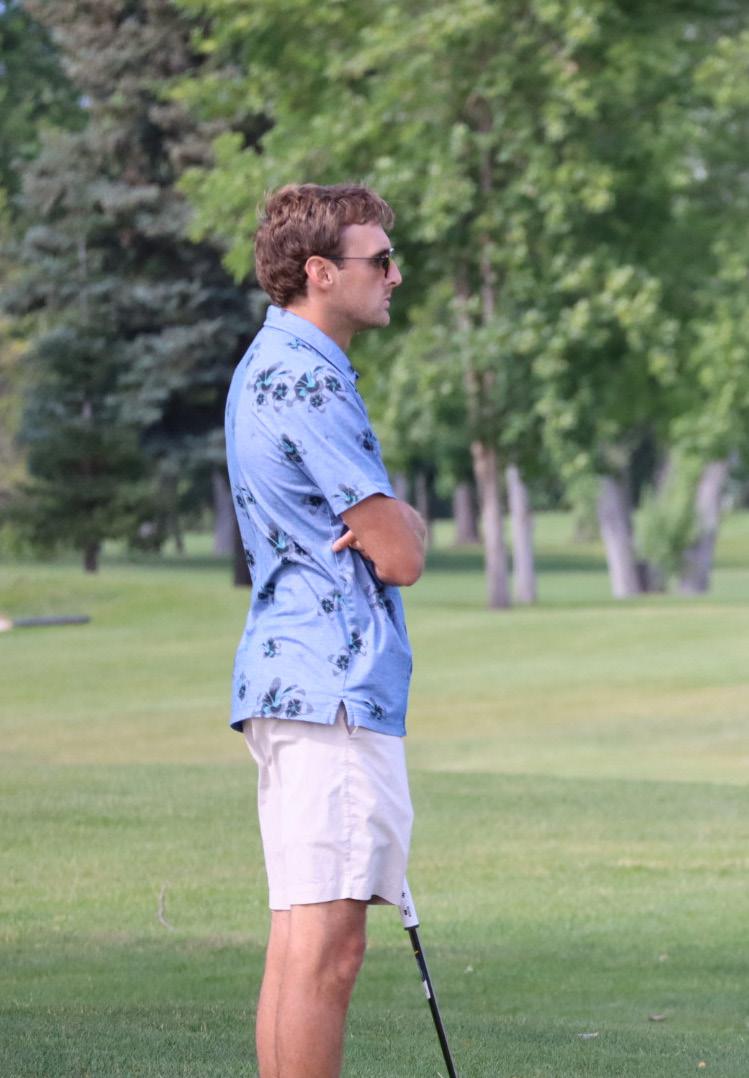
had reportedly made an ill-advised attempt to draw hot spring water from out of the ground, which Warner plugged up in an effort to “protect a river already battling high temperatures.”
Before Rumsfeld owned the ranch, another curious character, Charles Kuralt, had owned the land until his death in 1997. Kuralt, a longtime journalist for CBS who among other things hosted the Sunday morning program

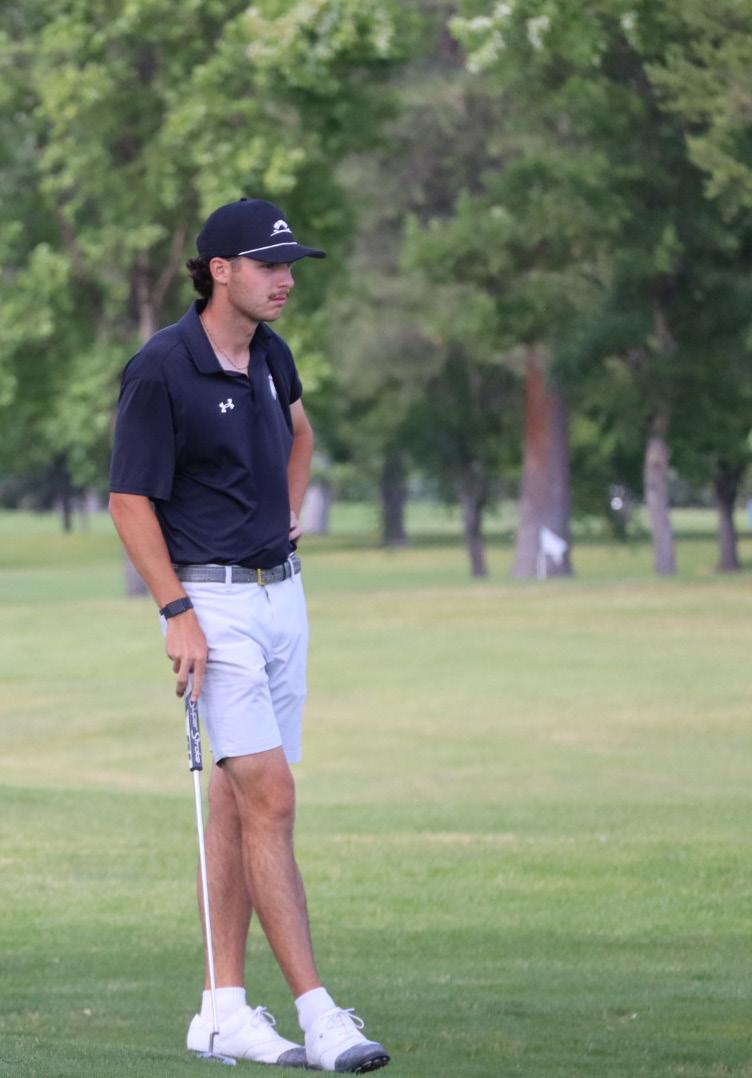
for fifteen years, became even more famous after his death when it was reported that for three decades Kuralt had a second “shadow” family living at his ranch in Montana. There’s even a cabin still standing within view of the golf course that Twin Bridge residents refer to as “Mistress Cabin.”
With no clubhouse being built and four cottages intended for his kids on the property, it’s still unclear exactly who will be playing the Scottish-style links when it is finished, aside from Warner’s “family, friends, and customers.” The currently unnamed course will operate as a private establishment, but Warner assures the skeptics that he’s not trying to build another Yellowstone Club. “I’m not a developer,” he said, "I don't have a single member. I don’t have a single jet.”
While the Twin Bridges community has seemingly softened its stance on Warner’s golf course project, given his conservation efforts, there are still those that worry about a potential culture shift happening in an area with strong ranching traditions that go back generations.
Time will tell who Warner’s golf course will truly serve. There’s no doubt that Montana residents are a little skittish these days at the thought of another golf course for the ultra-wealthy popping up but considering his preservation background and eco-friendly changes that are already underway, perhaps Warner is drawing a new blueprint for the ranch-turned-luxury golf course scene in Montana.
Two Missoulians, Payton Taylor and Kade McDonough, both made their U.S. Amateur
Championship debuts this month at the oldest athletic club in the United States (1860), the Olympic Club in San Francisco. Competing against the best amateur golfers in the nation, the two Montanans had very distinct routes getting to the prestigious event.
For Payton Taylor, it was winning the Montana State Amateur Championship back in June at his home course, the Missoula Country Club. Taylor battled it out for an exciting one stroke win over McDonough, which along with Treasure State glory, granted him an automatic qualification spot in the 125th U.S. Amateur Championship.
Without an exemption McDonough had a little more work to do before he could book his trip to the Bay Area. The two-time Montana State Match Play champion made it through two extremely competitive U.S. Amateur qualifying rounds, first at the Ranch Club in his hometown where he finished in a tie for seventh place with a single round score of -4 (68), and then tying for third after duplicating the -4 (68) score at the Salt Lake City Country Club. From there it was on to the Olympic Club in San Francisco for the big event itself.
The competition itself started with a field of 312 golfers, including 47 of the top 50 in the Men’s World Amateur Golf Rankings (WAGR) and runs from AUGUST 151-17. The first two rounds were 18-hole qualifying stroke play, reducing the field to 64, before moving on to a series of match play rounds, culminating on AUGUST 157th for the 36-hole championship match. Along with a gold medal, the winner of the event will have exemptions for the 2026 U.S. Open and British Open Championships.
After the qualifying stroke play rounds, both Montanans just missed out on the cut with McDonough leading the way at +6 (146) over the two days, while Taylor finished up at +17 (157).
For results and more information on the U.S. Amateur, CLICK HERE
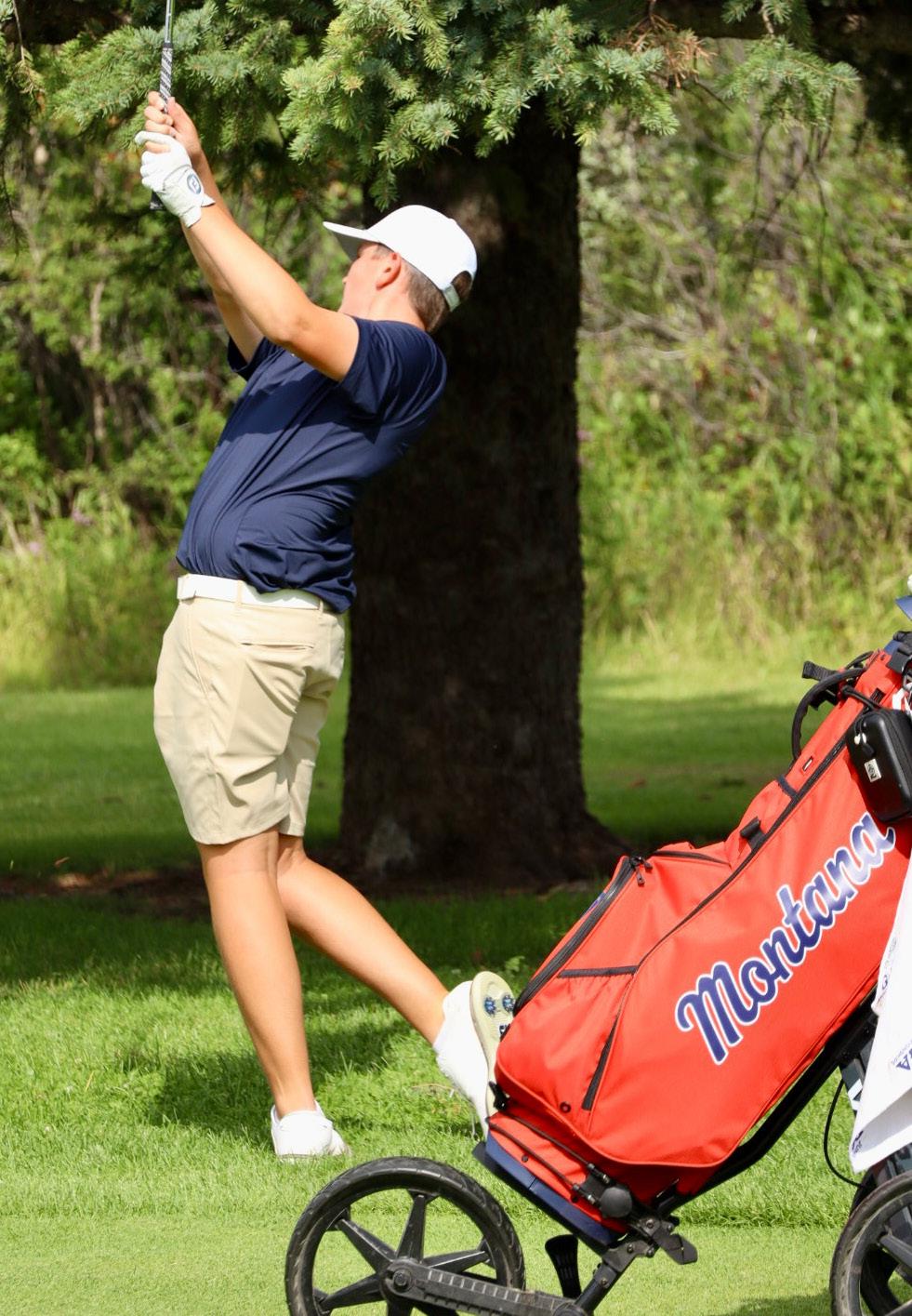
The 2025 Montana/Alberta Junior Ryder Cup Matches were contested at Magrath Golf Club, which was celebrating its centennial year. Magrath, just south of Lethbridge, Canada saw two days of competition on August 6-7. With 12 juniors (6 boys, 6 girls) representing both teams, 54 holes included matches in the following formats: Four-Ball, Foursomes (alternate shot) and Singles Matches over the two days.
The annual event rotates between Montana and Alberta. This year, representing the boys were: Austin Kaufman (Helena), Derek Schaefer (Missoula), Jack Schaefer (Missoula), Joseph Meusey (Missoula), Isaac Mosser (Billings) and Torren Murray (Kalispell). The girls were represented by: Clare Jensen (Billings), Cameron Burnett (Hamilton), Anna Fenhaus (Billings), Karlee Brown (Whitefish), Stella Jaffe (Whitefish) and Olivia Kamieniarz (Big Sky).
Singles matches on the girls’ side were the highlight as the girls won 5 points out of 18, including 3 by Cameron Burnett. Overall, the match saw Alberta claim victory 29.5 to 6.5.
Similarly, the boys saved their best effort for day two singles matches as they won 7 of 18 points with Derek Schaefer leading the way with 2.5 points in his match. Overall, Alberta won 25.5 to 10.5.
Congratulations to Alberta on their excellent play. Next year, Montana will host Alberta and look to bring one or two of the trophies back to the Treasure State!


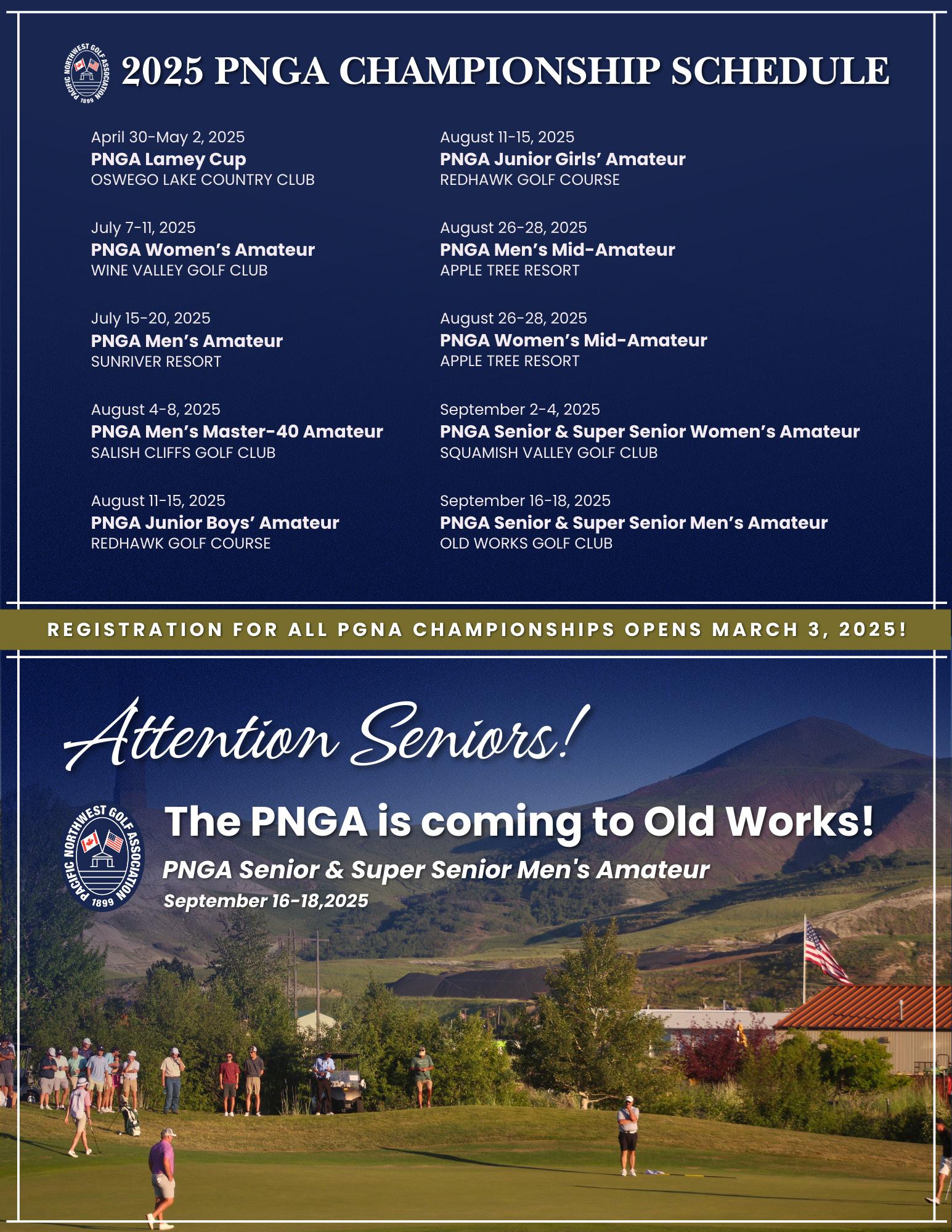

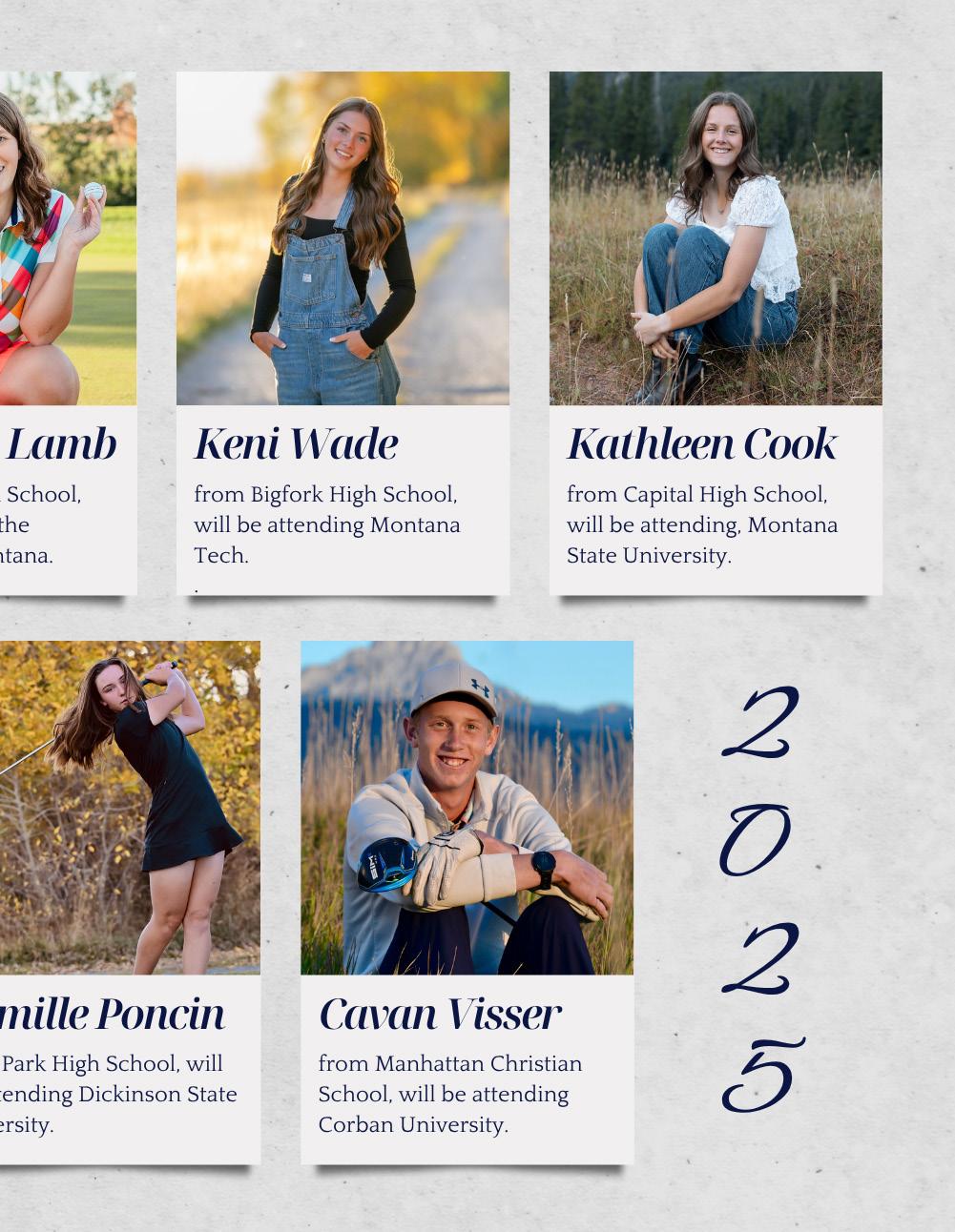
BY EMILY HULSEY Membership Operations Director
Part of my job includes managing the Handicap Department and answering questions about handicapping. However, since the World Handicap System includes both handicapping and course rating, the USGA now requires at least one association staff member to also be certified in course rating. Since our Course Rating team consists of mostly volunteers, I started this spring on the journey to certification.

To become certified in course rating, a person must do the following: 1) Complete online education, 2) Attend at least 5 course ratings, 3) Pass an online test, 4) Complete an online Calibration, 5) Attend an in-person Calibration.
I already knew some things about course rating. My Dad was a course rater in the 80’s and 90’s, and I would sometimes help pace greens and enter numbers into the computer. I even remember when the Slope Rating™ was introduced! And, I’m familiar with the
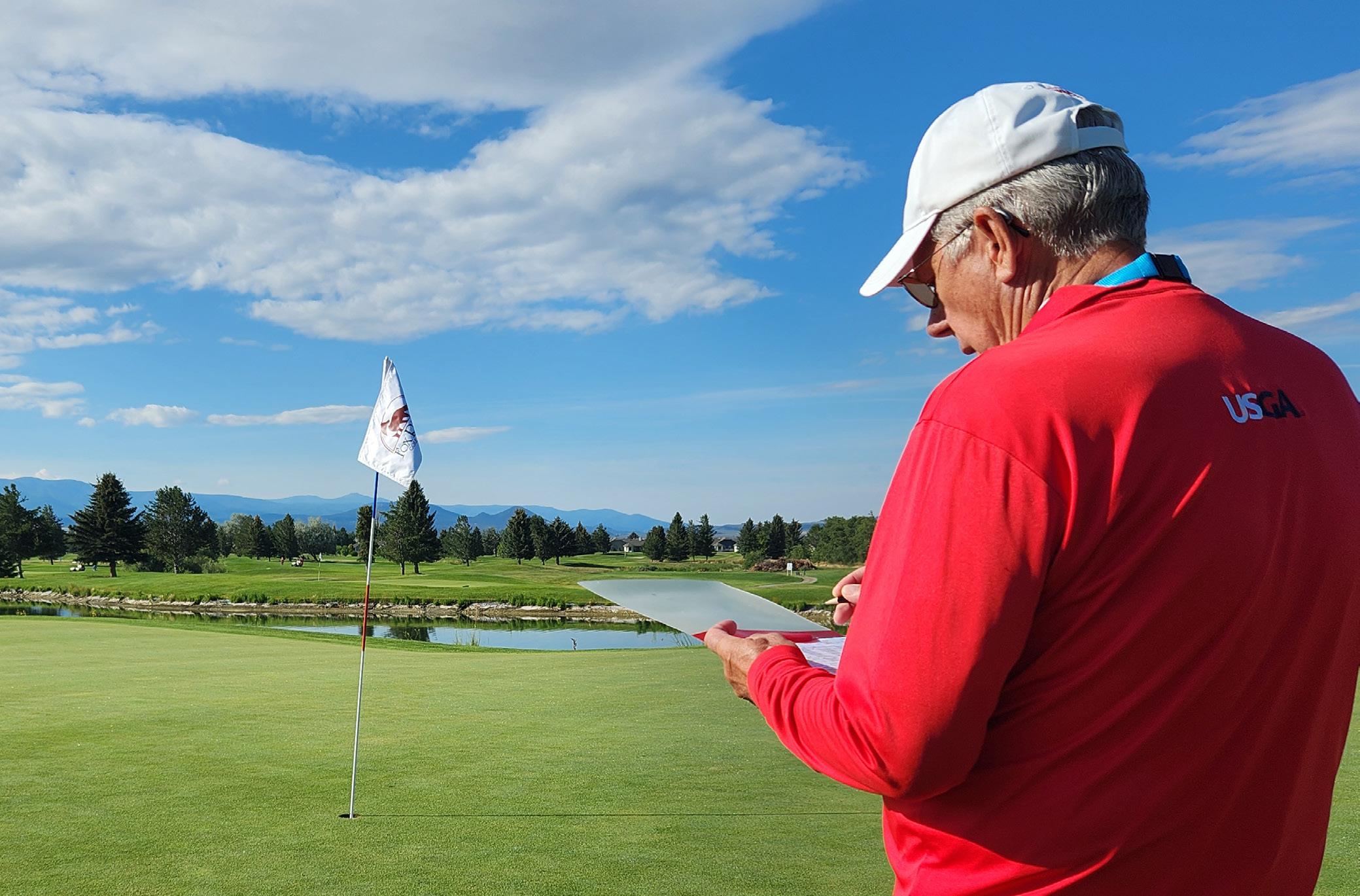
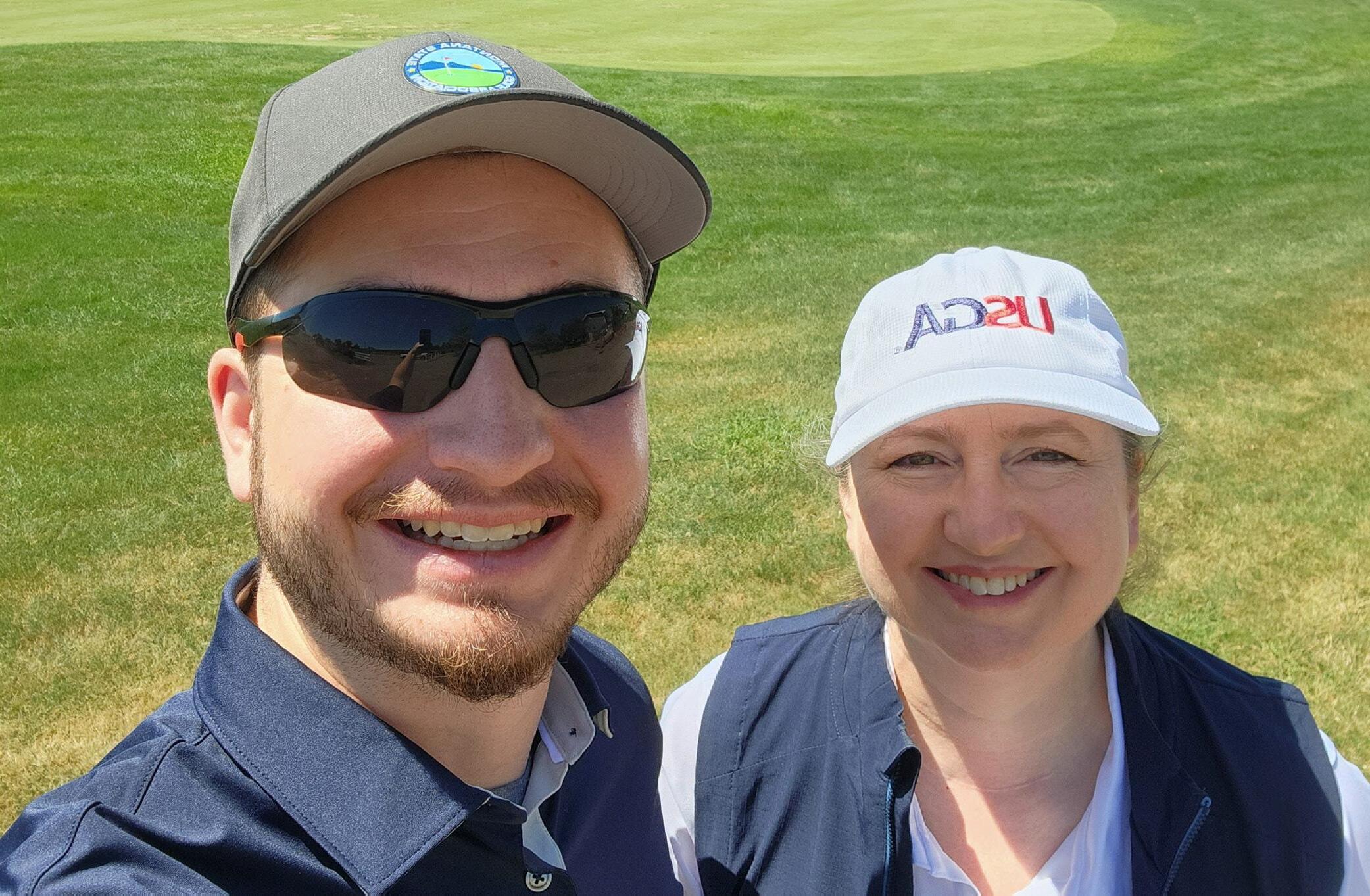
end-process of course rating, as I help publish the ratings and send reports to the clubs.
However, learning about what our Course Rating team does was both interesting and eye-opening, to say the least! Handicapping is a pretty straight-forward process of plugging numbers into formulas. Course Rating is a complex system of over 16 obstacles and factors, with 55 possible adjustments! The Course Rating™ system has really evolved in the last 30 years!
My journey started off in early spring by completing the USGA’s online education and then attending our team’s annual training in Billings in May. I rode along as they rated Pryor Creek’s Elmer Link and Johnny Walker courses that week.
To better streamline the process, a good part of the rating is done ahead of time on Google Earth Pro, recording many measure-

ments and elevations, and making note of any obvious obstacles. Then, it’s finished in person by double checking lengths and observing many obstacles that can’t be seen on Google, such as stance & lie, roll, bunker depth, mounding, rough height, lateral & crossing obstacles, green surface, and so on. The “homework” must be done ahead of time by each rater for the tee they are assigned. Otherwise, the team would be there all day!
Our Course Rating volunteers are usually well-received on the course, but, sadly, they are sometimes under-appreciated! It’s not an easy task, but the team does their best to get their job done as efficiently as possible, and at the same time, try not to be a disruption.
Over the years, I’ve heard some complaints about course rating, in general. The most common one is when people try to compare one course to another. “The course across town
is much harder, so why is our course rated higher?” One of the biggest things I’ve learned during this experience is that it’s impossible to compare one course rating to another. Why? There are so many factors that go into a course rating, it would be futile to try. The biggest factor is length. Everything else either “adds” to the length (or difficulty) or subtracts from it. Is the average wind speed different, the roll of the stimpmeter, or elevation differences from tee to green? What about the course’s topography (especially in landing zones), the number, depth, and location of bunkers, the size and distance of crossing and lateral obstacles, the number and density of trees, or the size and difficulty of greens? What is the condition of the turf or the width of the fairways? There are so many factors and adjustments that are considered, where would you start the comparison?
Another misconception is that a course rater might “taint” the rating based on their ability. However, the USGA is very clear that we rate the obstacles “in accordance with the Course Rating System Guide, not based on how you would play the hole”. Each tee is considered for both men and women, scratch and bogey. There are set landing zones for each

of these categories. The Course Rating guide is laminated and a permanent appendage for each Course Rater, and the adjustments, tables, and guidelines are constantly referred to during the process. I know that I’ve already marked, highlighted, and broken in my copy in just a few months.
After the Pryor Creek ratings, I attended the ratings for Anaconda Hills GC in Great Falls, Lakeview CC in Baker, and Fox Ridge GC in Helena. With each rating, I’ve learned so much, and have come to appreciate our Course Rating volunteers even more!
All in all, it was a fun experience, and I look forward to learning more on my road to certification. It will take some time, but I’m very grateful for the depth of knowledge, experience, and patience from our Course Rating team!
I would also like to thank our member clubs for graciously receiving and accommodating our course raters. Since we only come around every 8-10 years, it’s nice to feel welcomed and appreciated for our efforts to deliver this valuable service. We love the hard-working staff and superintendents of our clubs!

An MSGA Volunteer gets a green speed reading during a recent course rating.

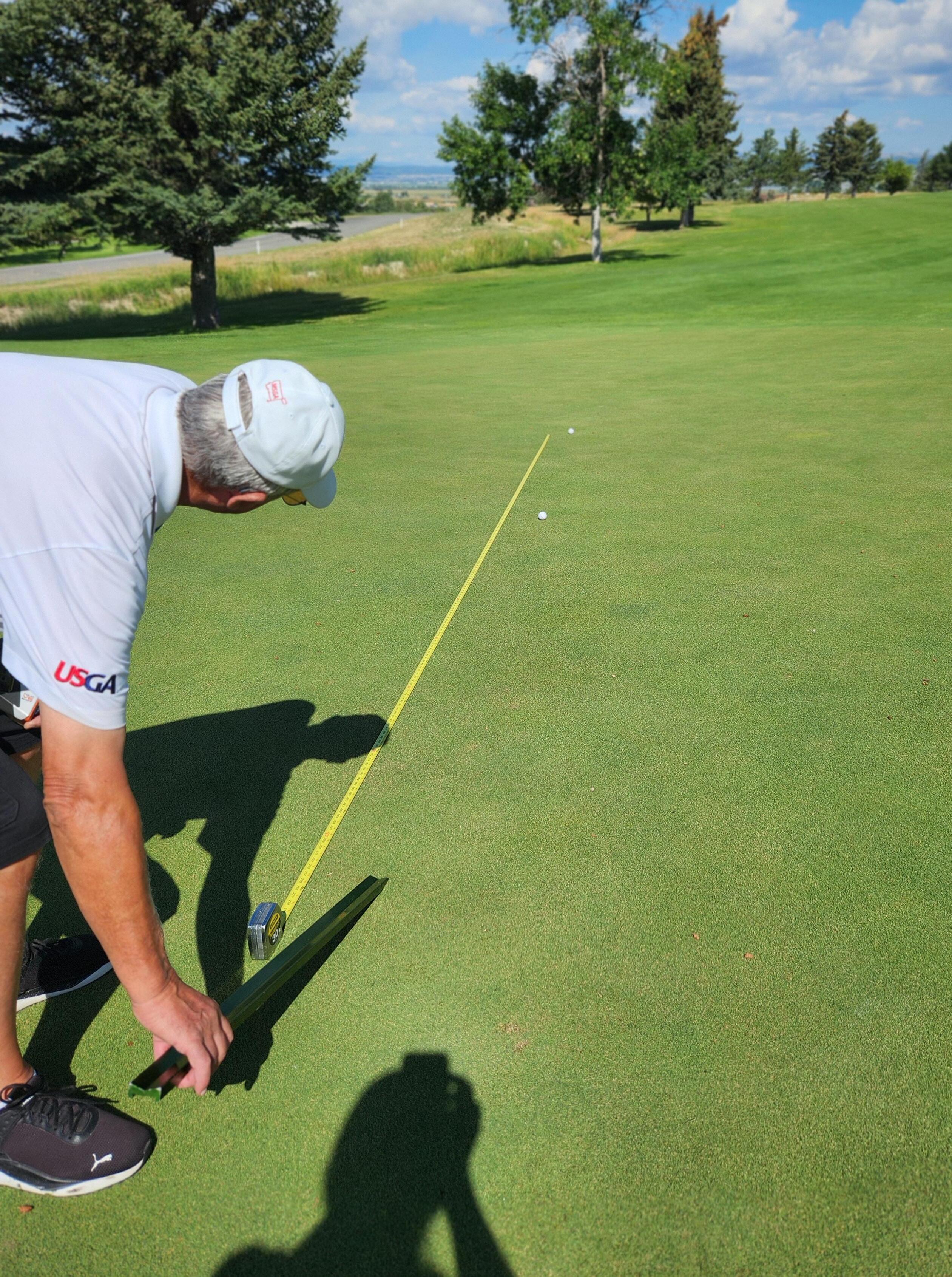
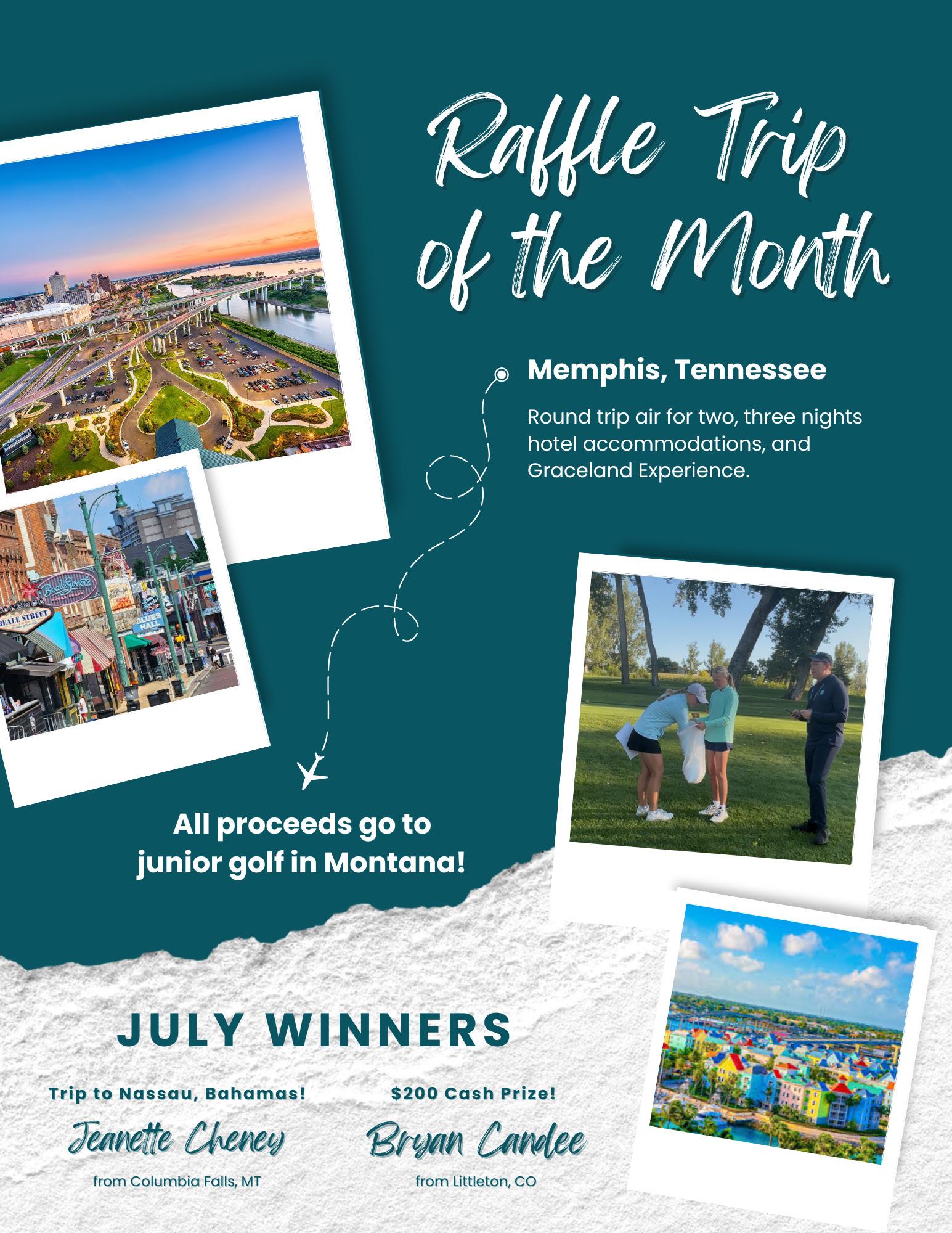

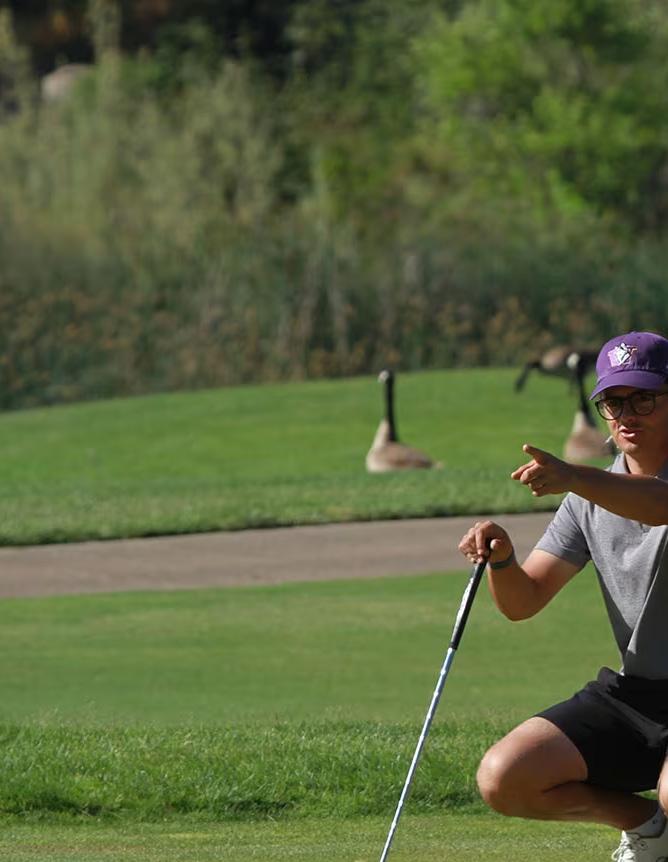
BY DAVID SCHEFTER USGA Senior Staff Writer
Sometimes Jacob Goode will stop and stare at the impressive display. He calls it the Johnny Miller Shrine. It’s a popular spot for members and guests of The Olympic Club, a place steeped in golf history. Miller, the 1973 U.S. Open champion and former club member, made a lot of it. But others are featured in the dedicated display near the men’s grill.
There are items belonging to Ben Hogan, who was the (shocking) runner-up to Jack Fleck in the 1955 U.S. Open... Then there’s Yuka Saso’s golf bag from her 2021 U.S. Women’s Open triumph, and the caddie bib for Megha Ganne, the Stanford University star who earned low-amateur honors. Other oneof-one items like varsity jackets given to marshals, ticket stubs ... even yardage cards from the various USGA championships – five U.S. Opens, three U.S. Amateurs, a U.S. Junior Amateur and the inaugural U.S. Amateur Four-Ball a decade ago.
“It’s all cool,” says Goode, the reigning club champion who will get to make his own Olympic Club history this week when he tees it up in the 125th U.S. Amateur. “You definitely get a sense of history when you walk into it. They did a great job…You really see the evolution of the [Lake] Course.”
There’s no counting the number of rounds the 22-year-old Goode has played on the club’s famed Lake Course – the companion Ocean Course will be the stroke-play co-host venue –since he and his family first joined more than
a decade ago. But this will be the first time he sees it under exacting USGA championship conditions: high rough, lightning-quick greens and challenging hole locations, some he may have never seen.
“The course is so different [right now],” said Goode. “It’s a lot more penal because the rough is much higher. I’ve been dying for [our maintenance staff] to grow the rough out. I enjoy the challenge of it. It’s been nice to play [the course] recently. I feel I have an advantage of chipping out of the rough and [I] know what [the ball] is doing. It’s been great.”
Two months ago, Goode was unsure if he’d be teeing it up in his “home” U.S. Amateur. For the past four years, he’s been essentially a freelance golfer while attending the University of Washington. A self-admitted late bloomer, Goode was not recruited out of high school; he briefly chatted with the University of California-Davis coach, but they passed on him.
Goode decided to enroll at Washington –over the University of Colorado – with the hope of possibly gaining a spot on the team. At the time, his game was not Division I worthy, and he didn’t have any positive results to make the Washington coaches confident he deserved a look.
Things gradually evolved over the next 3-4 years. It started with him finding a swing coach in Southern California in February 2024. Wowed by Dana Dahlquist’s swing videos on Instagram, Goode sought out the instructor based at El Dorado Park, a popular public track in Long Beach. One visit on his way to the Titleist Performance Institute, in Carlsbad, con-
vinced Goode that Dahlquist was the right guy. Dahlquist clientele includes a number of prominent players, including two-time U.S. Open champion Bryson DeChambeau and multi-PGA Tour winner Viktor Hovland, among others.
Seven months later, Goode won the club championship, and in June, he claimed his biggest victory to date, the California Amateur, which earned him an exemption into the U.S. Amateur.
The transformation has been quite remarkable.
“I wasn’t smart enough to see how good he [actually] was,” said Washington coach Alan Murray. “Naively, I didn’t pay as much attention as I should have. It tells you about his passion for the game. Once you start peeling the layers of the onion back, you can really see how committed he is to being the best he can be.”
Goode’s story is not unlike that of Paul Chang, the former University of Virginia club

player who incessantly begged the Cavaliers’ coaches for a chance until making a run to the quarterfinals of the 2023 U.S. Amateur at Cherry Hills Country Club outside of Denver. Chang went from unheralded club player to helping Virginia finish runner-up in this year’s NCAA Championship.
Goode is hoping for a similar result, although he’ll only have one year of college eligibility as a fifth-year senior for the 2025-26 season. Murray and his staff tried to get Goode on the team last fall, but NCAA bureaucracy got into the way. Translated: the Huskies’ roster was full and Title IX compliance prevented the staff from adding another player.
Prior to that, Goode considered playing for the school’s club program, but he didn’t want to buy clothing or do fundraising. He took a job at Sahalee Country Club, site of the 2010 U.S. Senior Open, where he ran into the captain of the club team. He asked Goode why he didn’t want to play club golf. Goode, then a

“tweener” between being good enough to play high Division I golf, responded that he had loftier goals.
Jacob Goode was dialed in during the California Amateur final, defeating Southern California's Evan Liu, 8 and 6. (Jacob Goode)
A few months later, the two wound up playing Sahalee and the club captain saw the reason for Goode’s bravado. He shot a tidy 67 on one of the top tracks in the Pacific Northwest. The club golfer quickly saw why Goode never joined. Earlier this year, Goode considered entering his name in the transfer portal, even without a college résumé.His California Amateur win might have drawn some interest, but the Huskies would officially nab him at the conclusion of the school year – before Goode could consider the portal any longer.
“He’ll be a really good presence on the

course and off the course as well,” said Murray, whose 2025-26 team doesn’t feature a lot of upper classmen. “We had a lot of freshmen last year and their tendency is to live and die with every shot. Jacob’s an older kid. He’s naturally mature. Just when you watch him play golf, he’s very sort of serene. He’s steady.”
Goode’s work with Dahlquist started showing major dividends last September during his run to the Olympic club championship. All five of his matches were relative blowouts –nothing closer than 4 and 3 – and he defeated two-time Northern California Golf Association Stroke Play champion Daniel Connolly in the final. Connolly, who played at Southern Methodist, had advanced to the Round of 32 in the 2013 U.S. Junior Amateur at Martis Camp and qualified for the 2022 U.S. Amateur Four-Ball at the Country Club of Birmingham.
“He’s a NorCal legend,” said Goode.


But Goode barely had time to celebrate the victory. One quick toast at the championship dinner, and he was bolting for the airport to fly back to Seattle for the first day of fall classes. The next morning, he was seated in a Polarization of Congress class as part of his political science curriculum.
“I wish I could have been there all night [to celebrate],” said Goode, who doesn’t get emotional over tournament victories. “I wasn’t playing on the U-Dub team [at the time], so I needed something. I figured I might as well play in [the club championship].”
With Washington on the quarters system, spring classes don’t end until early June. When most college kids are coming off of NCAAs and/or playing the Sunnehanna Amateur and Northeast Amateur – both in June – he’s just completing finals.
To prepare for the California Amateur at Granite Bay Golf Club outside of Sacramento, he entered the Southwest Amateur at Desert Mountain Golf Club, in Scottsdale, Ariz.
After missing the cut there, Goode, drove to Sacramento and not only advanced into the 32-player bracket from stroke play, but he quietly rolled through his opponents, eventually meeting 16-year-old wunderkind Evan Liu from Southern California in the 36-hole final.
“I had two days to practice for the state amateur,” he said. “I didn’t know where this was going to go. I knew I had the ability. I somehow know where the ball is going. Just swing hard and see where it goes. And my putting was OK. I was doing that all week. I think I was 1 under [par] every round, including the match play. I was just super consistent.”
That laissez-faire attitude paid off. Even while sitting in his hotel room yearning to be back home in the Bay Area, Goode stayed focused, knowing full well that a victory would land him a spot in the U.S. Amateur at The Olympic Club.
Against Liu, a rising high school junior who
recently represented the West in the American Junior Golf Association’s Wyndham Cup, Goode thought his day might go well on the second tee when his 2-iron landed right next to Liu’s ball that was struck with a driver. Using length and experience to his advantage, Goode built a 3-up lead at the lunch break. By the 27th hole, he was 7 up. Laser focused, Goode still had to be reminded of the match’s status.
A self-admitted late bloomer, Jacob Goode will finally get his shot at playing Division I golf as a fifth-year senior this fall at Washington. (Jacob Goode)
“I asked my caddie how many am I up by?” he said. “I had no idea.”
Three holes later, the 8-and-6 triumph was complete as Goode added his name to the prestigious list of champions that includes Miller, John Cook, and two-time major champions Mark O’Meara and Xander Schauffele. Plenty of text messages followed, and his name was circulated in The Olympic Club’s digital newsletter. His name was starting to make waves across the state, and the UW golf bag didn’t hurt, either. Goode, in typical fashion, remained non-plussed about the accomplishment. He was more concerned about getting a good meal that evening than popping champagne corks.
But the victory did validate all the work he put in. And it sent a message to those who doubted his abilities going back to when he first began competing as a high school sophomore.
“I proved a lot of people wrong in some regard,” he said. “There were other juniors and ams who didn’t think much of me when I started.”
Of course, around The Olympic Club, which features a state-of-the-art downtown athletic facility that involves a number of other sports, his triumph just added to its long championship pedigree. In 1964, club members Miller
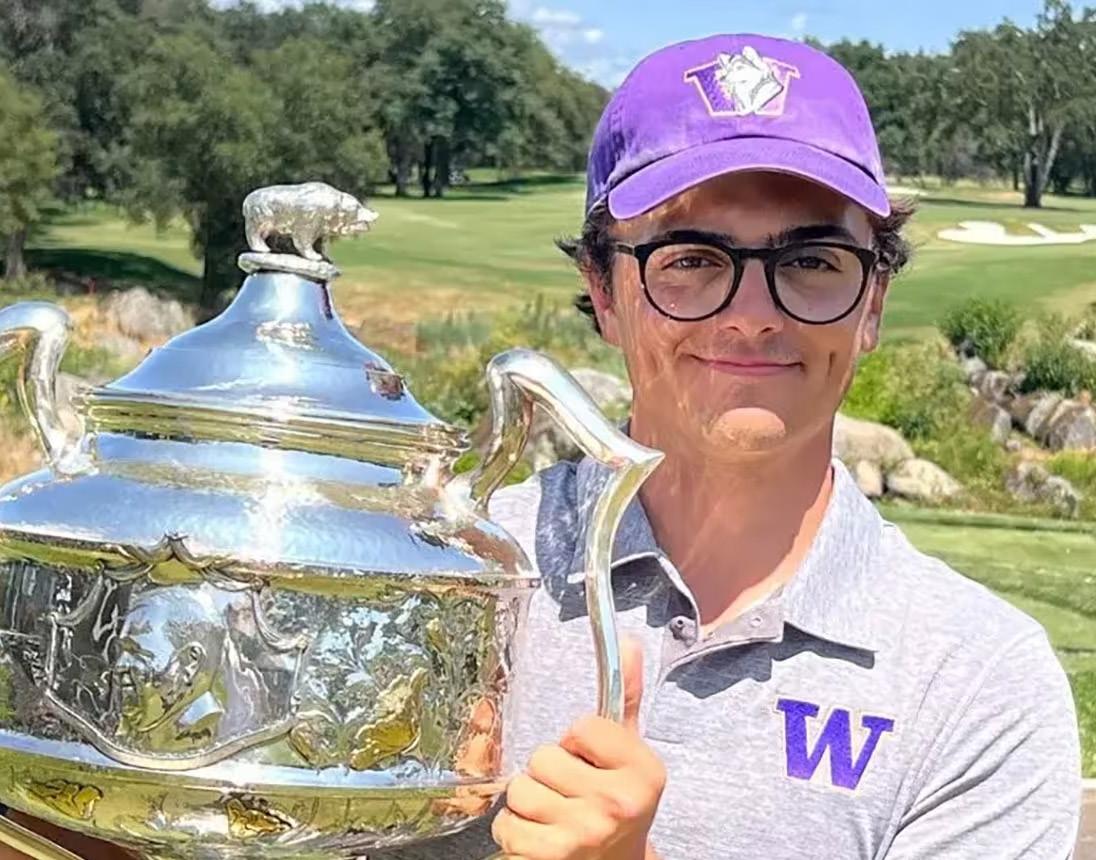
(U.S. Junior Amateur), Ken Venturi (U.S. Open) and William Higgins (U.S. Senior Amateur) all won USGA titles. And never mind all of the Olympic medals hauled in by members, a list that includes LPGA Tour Hall of Famer Lydia Ko and swimmer Ryan Murphy.
“When you are working out at the gym, you see the medal count and you’re like, ‘What am I doing here?’ Somebody is always winning something.”
Goode already has added his name to Olympic lore, even if it’s on a smaller scale. That could change at this week’s U.S. Amateur. In 2007, the club was represented by member Randy Haag and former junior member Joseph Bramlett, who is now on the PGA Tour.

Goode should draw plenty of attention from the “home” folk, and if he can make a deep match-play run, expect the galleries to swell.
But pressure? Goode won’t let himself be bothered by the outside noise. It’s not part of his nature.
“The most pressure is on stroke play,” he said of the field that will be trimmed from 312 to 64 after 36 holes on Monday and Tuesday. In 2007, the cut for match play came at 7-over 147. “In match play, you can do whatever you want. It would be an unreal experience, even if I lose in the first round, third round or get to the final.
“Not many get this chance. It’s a huge privilege. It’s going to be a lot of fun.”
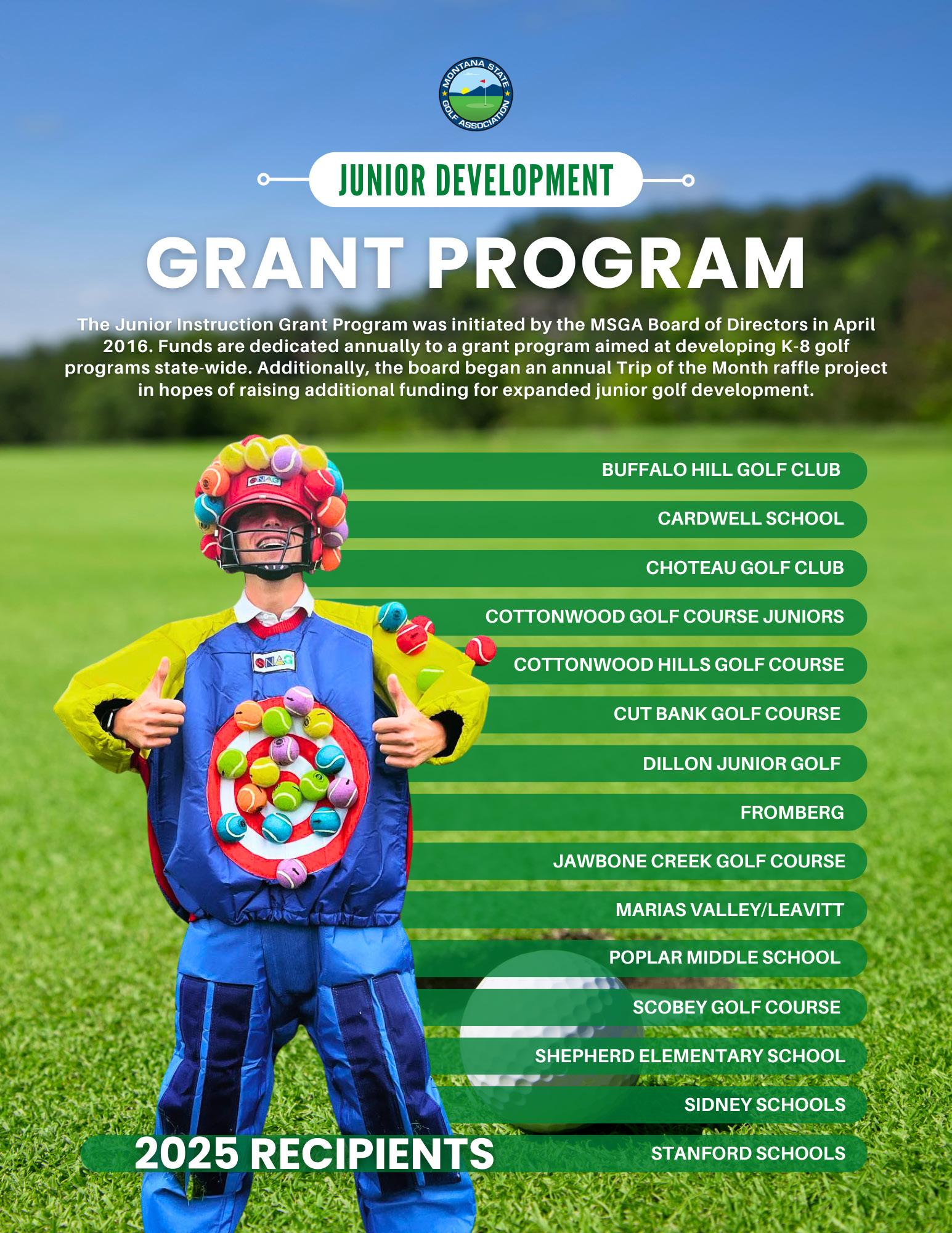



BY JIM CORBETT Mr. Golf Etiquette
After terminally ill patients, the group most likely to exhibit the five stages of coping are mediocre golfers. (Of the world's roughly 50 million golfers about 49 million are mediocre golfers. The remaining million consist of approximately 15 terrific golfers and a whole bunch of really terrible golfers.)
The similarities between terminally ill patients and mediocre golfers go well beyond their use of coping mechanisms. For instance, both groups share an impending sense of doom (especially true for mediocre golfers right before they hit the ball), and both groups know their plight will not improve unless a miracle occurs.
In order to understand, and perhaps assist the mediocre golfer, as he moves through the process, it is important to be able to recognize and distinguish the various stages. Let us explore the stages and some of the typical symptoms that accompany each. Last week we discussed the first two stages, Denial and Anger. This week we’ll hear about the final three stages: Bargaining, Depression and Acceptance
It is pretty clear when a mediocre golfer enters the bargaining phase of his development. In the bargaining phase the mediocre golfer places a great deal of faith in the idea that some new technology will be developed to fix the exact thing that is wrong with him -- even though he usually doesn't have any idea of what that exact thing is. Consequently, a great deal of money can be spent on new equipment with features that are designed to give you
greater distance and greater accuracy regardless of how you swing the club.
The devil's bargain becomes: the more money I spend, the greater the likelihood that I will hit the ball straight and far. It doesn't always work that way, but it doesn't really matter since once the $350.00 is spent, there is a much greater ‘perception’ that the ball is going straighter and farther. This syndrome could be referred to as "The Emperor's New Golf Clubs."
But technology is not the only area in which mediocre golfers are inclined to bargain. In fact, there is no area in which they will NOT bargain. If bargaining with the equipment manufacturers fails and bargaining with the instructors fails and bargaining with the other members of the foursome fails, the mediocre golfer will even seek supernatural help.
Praying, meditating, channeling -- these are all quite common on the golf course. There have even been episodes of ritual sacrifice out on the links. This behavior is not to be encouraged though, since it can really affect the pace of play.
As usual though, when one is dealing with a supernatural power, great care must be taken to be specific about your requests. I once went through a period of time when I was playing very erratically. I'd make one good shot and then a few bad ones, one bad shot and then a few good ones. So I prayed that I would play with some consistency. I guess you could say that my prayers were answered, because all my shots became consistently bad.
The depression stage is certainly the most difficult for the mediocre golfer to endure. It is
during this phase that the mediocre golfer first realizes the situation is probably not going to get a whole lot better than what he sees right now. (Gee, that is depressing.)
Mediocre golfers may indicate they are in this stage when they stop keeping score. They may say things like, "It's not the score that counts, I just play for the exercise." Perhaps you've heard someone say they just play golf because they enjoy the people they meet out
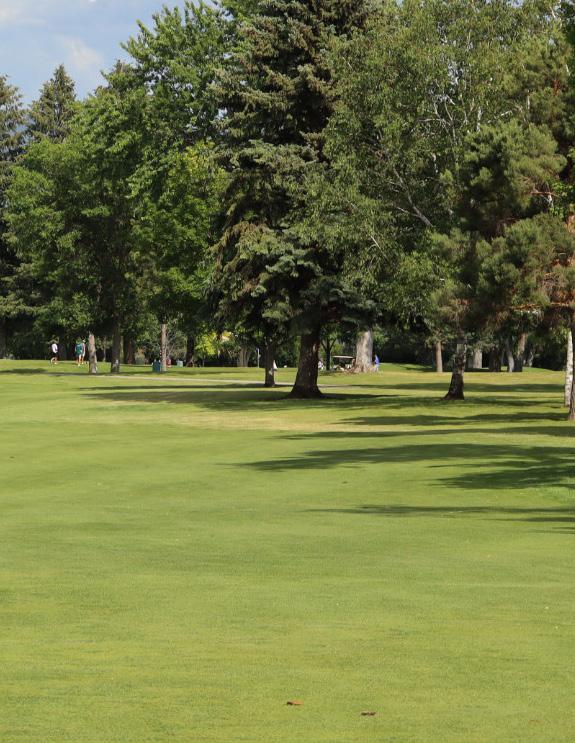
on the course -- this is someone who is deeply depressed.
The depression stage can be brought on by a wide variety of factors. There have been many instances in which mediocre golfers have been sent into the depression stage simply by watching video tapes of their own swing. It has also happened to some after they lost a round to their kids -- this is quite common if the kids are still in elementary school.

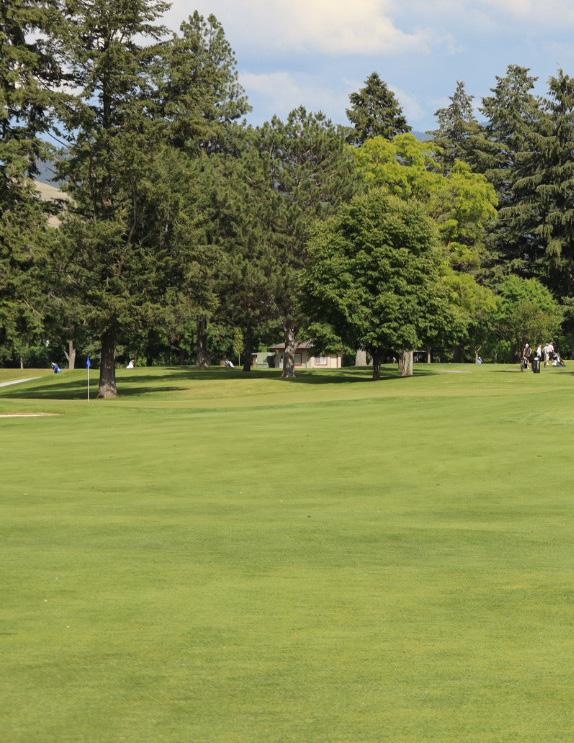
I have a friend who was sadly driven over the edge when I carelessly mentioned that I had read about a national blind golfers league in which some of the better players carry handicaps under 18. That was enough to make him hang up his spikes for over two years and he even contemplated gouging out his own eyes, with the hope of improving his game. I felt terrible.
Someone who is in the depression phase must be handled very carefully. You never know what extreme course of action they may take. I once had a close friend who was demonstrating some of the subtle signs of being in the depression stage, but being in denial myself, I didn't pick up on the clues at all. At one point he told me he was quitting. He had played his last game and now he was checking out.
I assumed that if he had a little time away from the game he'd soon be back in his usual high spirits. But a few days later I learned that he had tried to do himself in. He went to the local driving range and was riding back and forth in an open golf cart a little past the 100yard markers just laughing and laughing ... and laughing.
If a mediocre golfer has the stamina and enough of a support system to weather the depression stage, he may finally emerge into acceptance. The acceptance stage is not to be confused with a happy time, necessarily. It is merely the phase in which the golfer comes to terms with who he is -- a mediocre golfer.
It is a time of mediocrity with dignity. Gone is the need to alter the score. Gone the need to improve one's lie -- or to lie at all. Gone, too, is the need to buy expensive equipment in the futile hope of gaining a few paltry yards.
All of that is replaced by a simple appreciation of the game. It is during the acceptance stage that the mediocre golfer begins to truly
sense the beauty and joy of the game. The pressure to perform to external expectations is supplanted with a relishing of the journey rather than any particular destination.
A mediocre golfer in the acceptance stage can enjoy a lifetime of golf without the anguish that is the constant companion of golfers in other stages. For this golfer, the statement, "I play golf to relax." has a ring of credibility. In fact, by playing a more relaxed game of golf, the mediocre golfer in acceptance may, indeed, find that his game improves. But be careful! Don't improve too much or you'll quickly find yourself back in the denial stage!
There is nothing you can do to change how a person progresses through the stages of coping. Nor should you try. This is a natural process that must proceed at a pace dictated by the needs of the mediocre golfers themselves. However, if we are sensitive and understanding as their journey unfolds, perhaps we can assist them in accepting their mediocrity with all the most positive connotations of the word.
For more from Jim Corbett, visit his website mrgolf.com


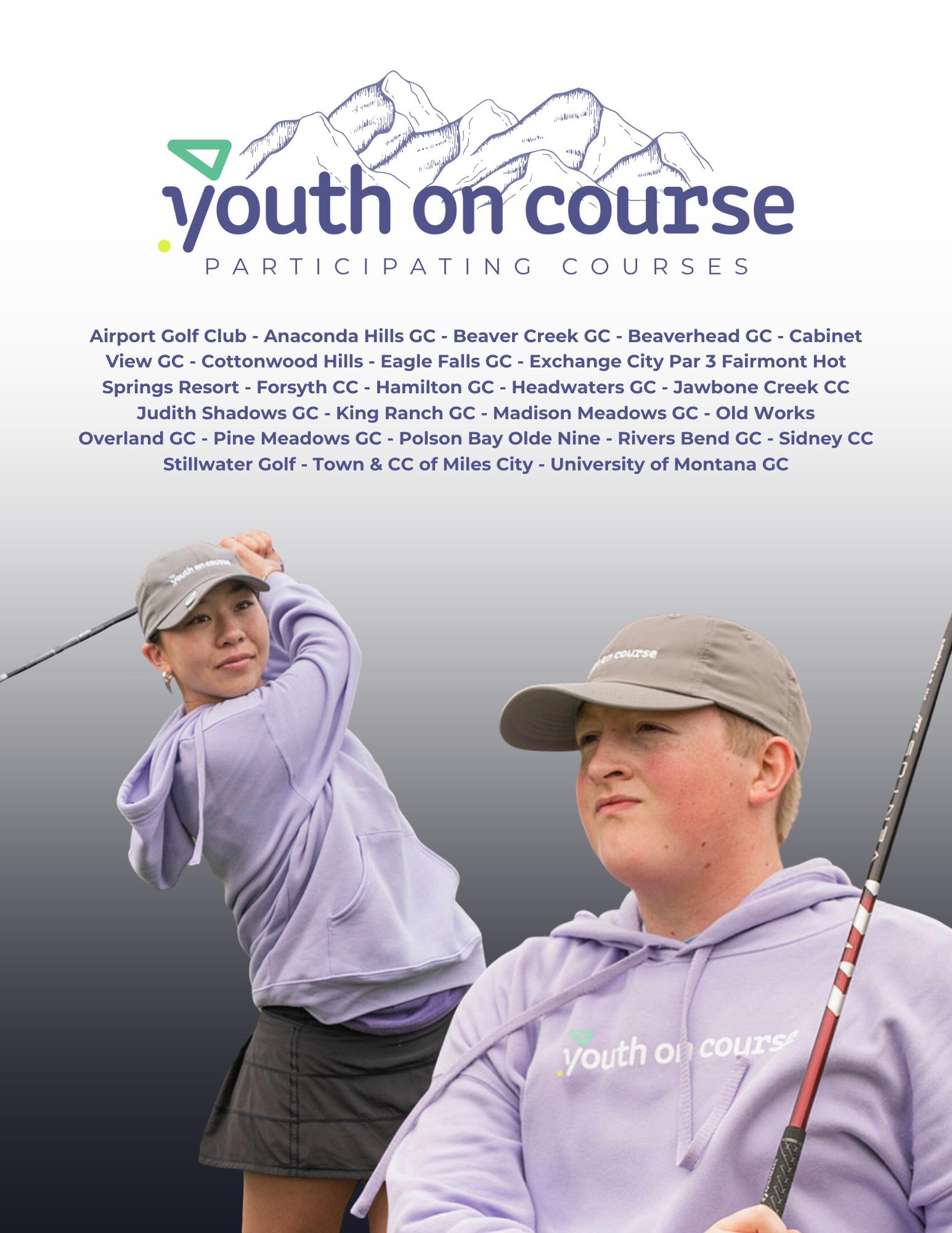

BY ROSS NIEWOLA AGRONOMIST, WEST REGION
Not all shade is equal. Some types of shade are much worse than others for turf health and growing conditions. When turf struggles in the shade it is often attributed to a lack of light, but we rarely discuss the type of light. Trees don’t just block light, they filter it. The total amount of light (quantitative shade) matters, but qualitative shade (the quality of the light wavelengths) is equally important.

Light wavelengths are measured in nanometers (nm) and affect turf plants in different ways. Below is a general breakdown of the turf-specific wavelengths.
- Critical for photosynthesis
- Promotes strong leaf growth and structure
- Often reduced in shady conditions, contributing to weaker turf



GREEN LIGHT (500-600 NM)
- Not as efficient as blue or red light for photosynthesis
- Mostly reflected, not absorbed by the plant
- Still plays a role by penetrating deeper into the turf canopy than other wavelengths
RED LIGHT (600-700 NM)
- Highly efficient for photosynthesis
- Works together with blue light to regulate plant development
- Reduced red light can impact turf growth and density
FAR-RED LIGHT (700-740 NM)
- Not used in photosynthesis but affects plant behavior
- Alters growth patterns like stretching and leaf size
- When increased relative to red light it can signal plants to grow taller and thinner as a stress response
- Can turn off certain growth indicators within the turf plant
In essence, trees filter out a lot of the “good” blue and red light and let the less useful far-red light through when the blue and
red light wavelengths are absorbed by the tree leaves for photosynthesis. This means that the turf is not receiving the quantity of light it needs for photosynthesis, and the diminished amount of light that is coming through has negative effects. This is like dying of thirst in the desert and the only water available is poisoned.
The next time growing environments and available sunlight are discussed at your golf course, remember that the quality matters as much as the quantity. Tree management and pruning increase the available light, and increase the amount of light in the blue and red wavelengths that reaches the turf below.
Click Here for more from the USGA Green Section Record ‒including the latest articles and videos on sustainable management practices that produce better playing conditions for better golf.



